How Far Can a Horse Travel In a Day? (8 Facts)
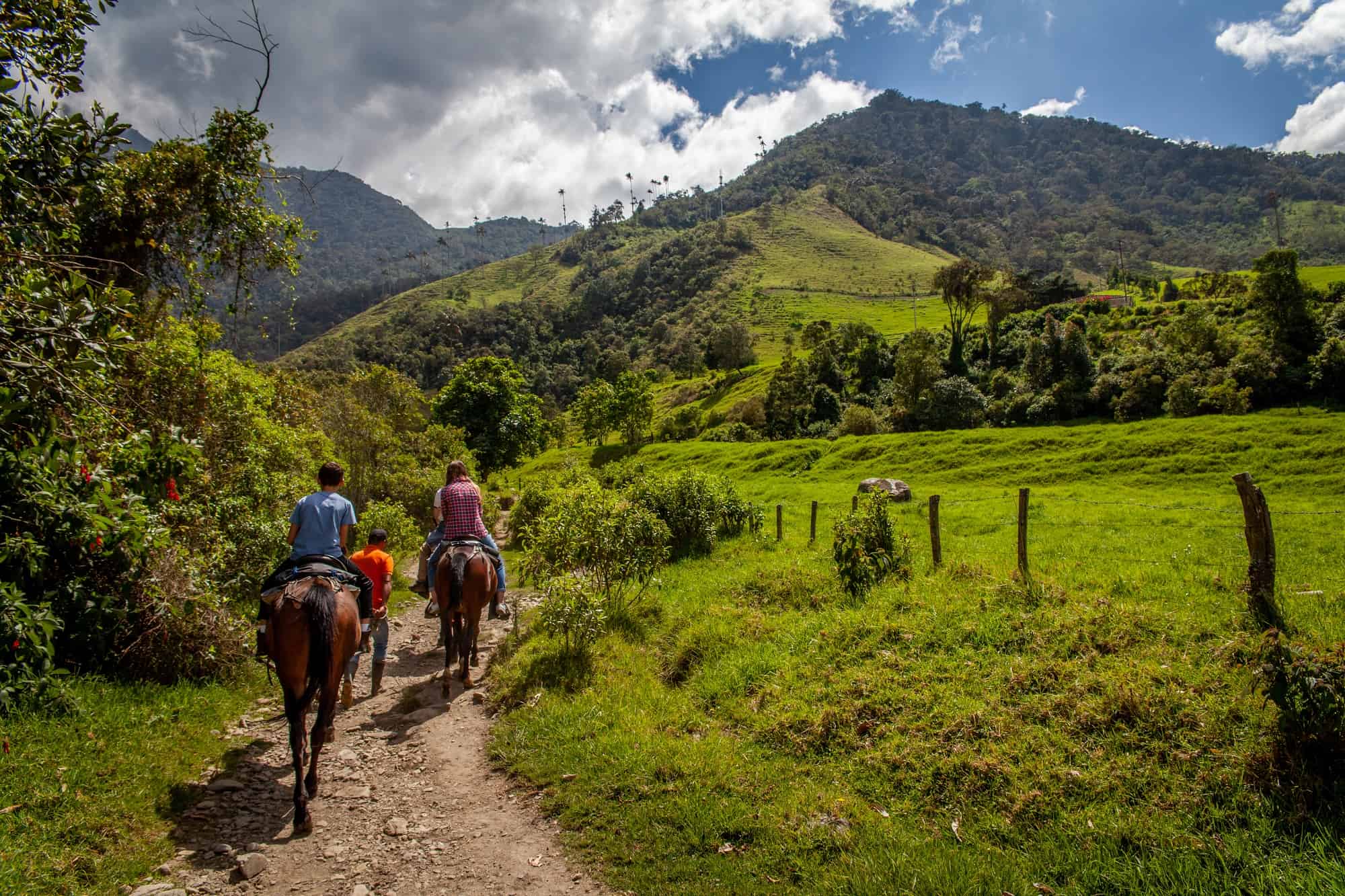
As no two horses are the same on the planet, there is no single answer to how far a horse can travel in a day. First, you should know that a horse moves its legs in three different ways, from the slowest gait, faster trot, and the fastest gallop.
Second, many different factors affect how much a horse can cross during the day, including the horse’s breed and age. However, its speed will also depend on the load it carries, terrain configuration, and weather conditions. Let’s take a closer look.

Today’s Horses vs. Horses in the Past
Always keep in mind that people use horses differently these days than hundreds of years ago. It is unnecessary to rely on these animals for long daily journeys, so they have adjusted to the new circumstances.
Unlike horses trained to complete everyday journeys in the past, modern ones are less capable of doing the same, with rare exceptions. While horses traveled about 35 miles (56.5 km) daily in those times, most of them can travel only 25 miles (40 km) a day nowadays.
How Far Can a Horse Travel In a Day
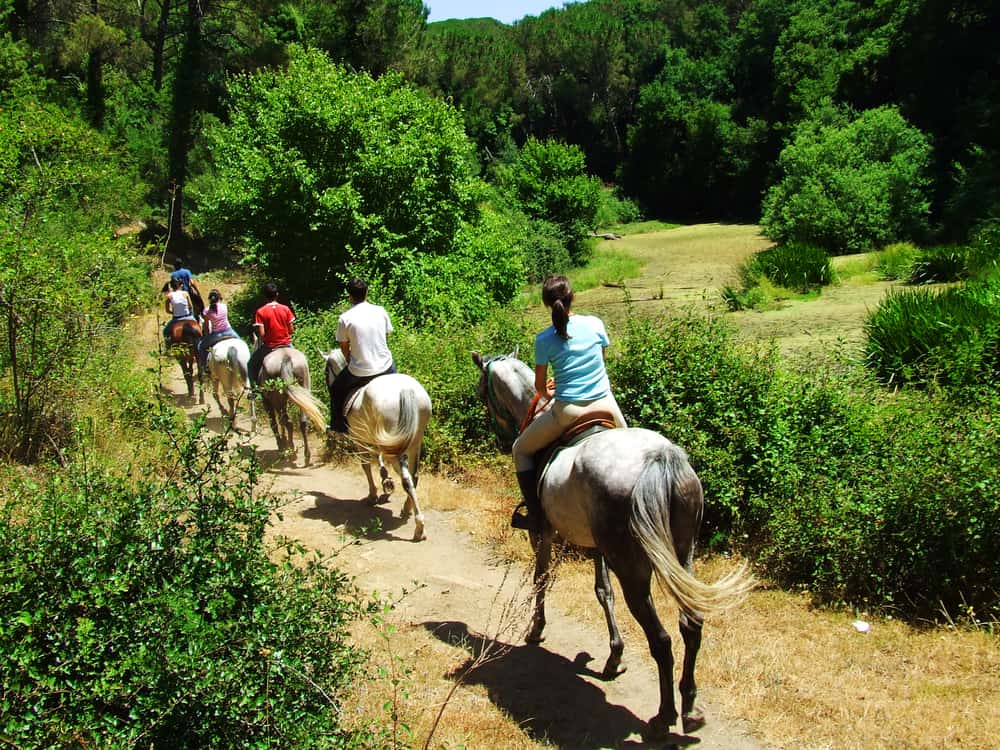
There are a few crucial factors that will affect your upcoming long journey. The primary things you need to take care of are your and your horse’s fitness and skills.
You both need to be rested, well-fed, and with an adequate amount of water supplies. Additionally, you should check your equipment, terrain, and weather conditions. Let’s take a look.
The mileage that a horse can cover in one day largely depends on horse movement types. The gait pattern depends on the horse you have.
Some naturally have efficient movements so that they can travel faster and further with less energy burning. Plus, they are more comfortable for the rider. You can recognize two gait types, including:
Natural gait
It includes walking, trotting, and running.
- Natural walk – A simple natural walk means a four-beat gait and covers up to 4 mph (6.5 km/h).
- Trotting – While trotting, a horse can move a two-beat gait at a speed of about 8 mph (13.9 km/h).
Ambling gait
It is a combination of natural and learned movements, such as cantering and galloping.
- Canter (lop) – It is a 3-beat gait that allows a horse to cover 10 to 17 mph (4.5 – 7.5 km/h).
- Gallop – It can be both natural and ambling gait type and means that a horse covers approximately 30 mph (48.5 km/h).
Horses can walk or gallop at a certain pace and an average speed per mile. It can vary depending on the horse type, rider skills, terrain, and weather conditions.
As I have already mentioned, a typical horse can walk at a speed of approximately 4 mph (6.5 km/h), trot at about 8 and 12 mph (13.9 – 19.5 km/h), while it can reach at least 25 and 30 mph (40 – 48 km/h) when galloping.
Never believe the famous scenes from movies. Most average horses can travel at the pace of a gallop only 2 miles (3 km) without fatigue and about 20 miles (32 km) at the pace of a trot. You can ride your horse 25 and 35 miles (40 – 56.5 km) without rest when it walks steady.
An average trail horse in decent shape can withstand a journey of 50 miles (80.5 km) in one day, while a fit endurance competitor will be able to travel even 100 miles (161 km) in a day. On the other hand, most of them can’t endure a few consecutive days of riding without a day or two of rest.
A more fit animal can cover more distance when trotting and cantering one part of the way. Be aware that there are no many riders who can sustain that pace. On the other hand, some horses can’t ride for eight hours in one day.
Horse’s health and fitness
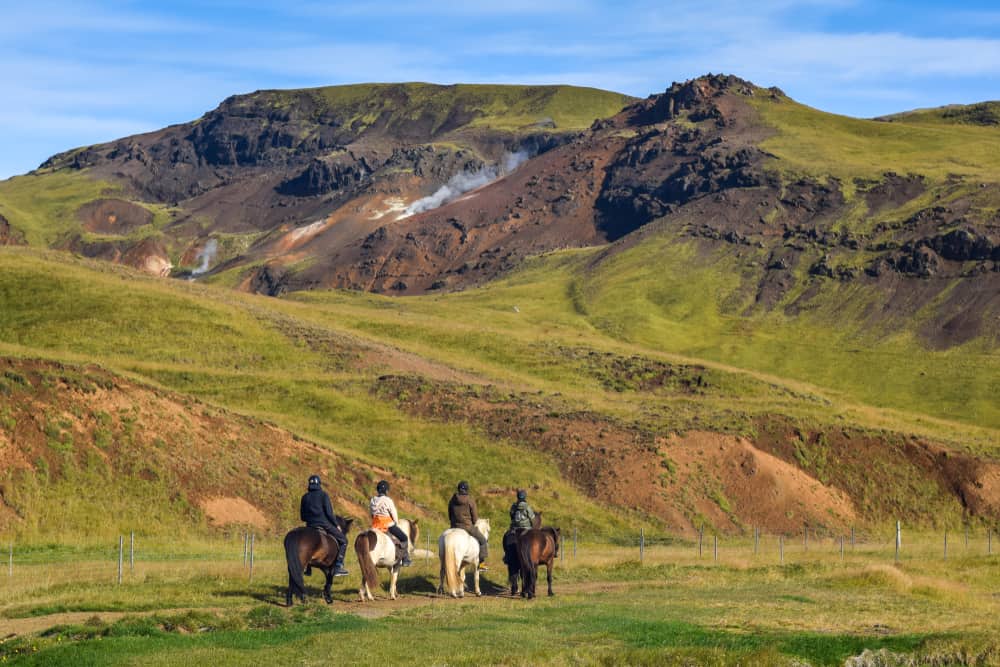
Regular exercise and training keep the horse healthy and excellently fit. However, it is recommended to take your animal to the vet for a detailed checkup before the journey. There are a few factors that will affect the horse’s overall fitness.
For instance, senior horses often have some health issues, like arthritis, and can’t spend hours on the trip and keep up with speed. It is the same with recently injured animals.
Keep in mind that horses tend to follow their team regardless of fatigue and pain. Therefore, you should take care to prevent overload. Tired animals can quickly stumble and are prone to injuries, so you should be careful and responsible.
The best option is to keep a reasonable pace, make frequent stops, and provide adequate riding equipment and enough food and water during the journey. Otherwise, you can face irreparable damage.
Keep in mind that there are a few techniques to improving a horse’s fitness, but it is a long process. It will be easier with a young, energetic, and healthy animal, but you should be less demanding with an older and less hardy horse.
Existing terrain and footing
Be aware that a horse can’t maintain the same rhythm of gait throughout the journey, and it often depends on the riding conditions. Every horse will slow down when facing unfamiliar and uncomfortable terrain, prolonging overall travel time.
As you can guess, it is not the same if you travel across the plains or the steep hills. Moving up and down will cause more stress on the horse’s cardiovascular system and limbs, so it can’t go as fast as over flat terrain.
Additionally, the hard, rocky, sandy, muddy, and bumpy ground will negatively impact the horse’s joints and hooves. Therefore, it will slow down the pace to avoid injuries. The best option for long-distance traveling is grassy fields.
Weather conditions
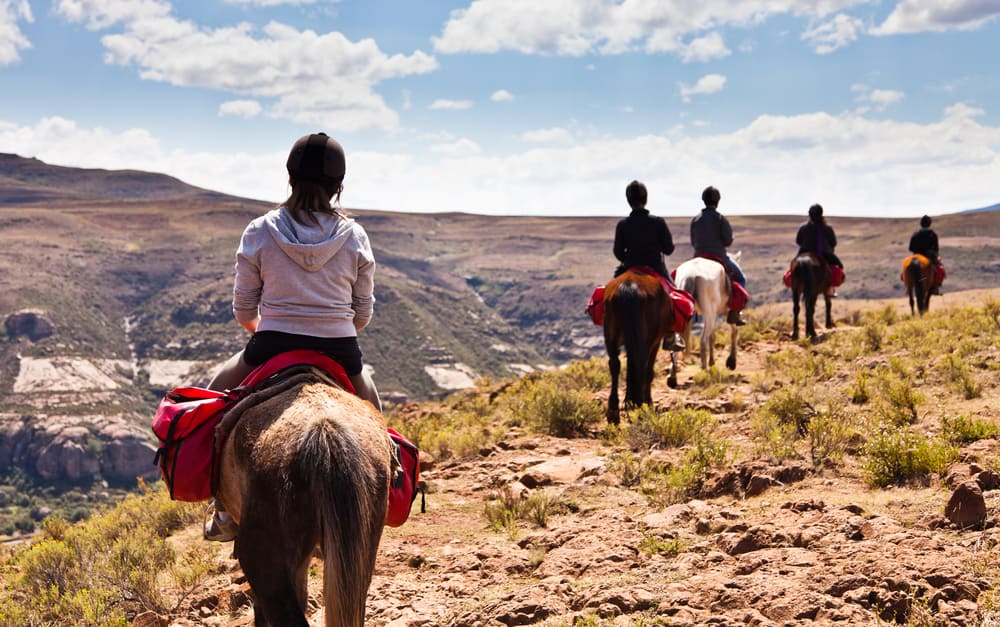
Always check weather conditions in advance and avoid taking a trip when the day is too hot or cold. Believe it or not, weather can significantly affect horseback rides, particularly when you plan a full-day trip.
Most horses do the best at the optimal temperatures of 70 and 90 F (21 – 32 C). Rainy days will slow your animal down, primarily because of the slippery ground. Plus, no one horse won’t enjoy getting wet. You can expect your horse to look for shelter after 2 to 7 miles (3 – 11 km) spent on rain.
In most cases, an average horse can travel about 10 to 20 miles (16 – 32 km) when it snows and temperatures are low. After that, they will seek warmth.
Additionally, extreme weather can cause severe horse injuries and illnesses. For instance, dehydration during hot days will cause a low level of electrolytes that is always followed by severe health consequences.
Keep in mind that hot, windy weather with low humidity can cause quick sweat to evaporates. You won’t notice sweating in such a situation because it dries quickly, but be aware that the horse can still lose electrolytes.
On the other hand, traveling during the windy and freezing days without adequate protective gear will probably cause muscles to stiffen, while frozen ground can hurt your horse’s joints and hooves.
Feed, water, and rest the horse
Fed and rested horse that got enough water will quickly complete a long ride and recover after that. Always check if you can find adequately arranged and accessible water sources on the trail, offer water to your overheating horse regularly and let it cool down and take a rest as much as it needs.
Properly fitting tack is one of the crucial things you should consider when riding the horse, especially when going on longer journeys. It is the same with the saddle and bridle.
Inappropriately fitting equipment will significantly influence your trip, shorten the distance you can pass during a day, and leave you unsatisfied and disappointed.
An additional problem is losing a shoe while traveling over the rocky terrain, making it impossible to continue the journey.
Rider’s skills and fitness
Finally, you have to be sure of your physical fit and capability to go the long distance in one day. For instance, if you are not skillful enough to guide your horse over rocky terrain or puddle, you can find yourself get stuck in the middle of nowhere.
Always check your stamina by traveling a few shorter trails before a long trip. As you have already known, riding a horse for hours is tiring and can be pretty painful. Even the most experienced riders will struggle to handle such an effort.
You can ride an average, healthy and energetic horse for 25 and 35 miles (40 – 56.5 km) in one day in ideal conditions. However, most of them will successfully handle only 15 and 20 miles (24 – 32 km) a day with enough water, food, and rest. Keep in mind that distance traveled also depends on you, weather conditions, terrain, and equipment you use.
Sharing is caring!
Related posts:
- How Fast Can a Horse Run? (Top & Average Speed)
- What Is a Baby Horse Called? (9 Facts About Baby Horse)
- How Much Does a Horse Weigh? (Average Horse Weight Chart)
- How Tall is a Horse? (Average Horse Height Chart)
Leave a Comment Cancel reply
Save my name, email, and website in this browser for the next time I comment.
Also Reading

12 Top Horse Documentaries Personally Recommended by Equestrians

Types of Horse Bits: Which is Right for You?

15 Top Tips for Renting a Horse Trailer

12 Beautiful White Horse Breeds (True & Fake White Identification)

What are Friesian Horses Used For? (9 Uses)

Are Horses Native to America? Where Do Horses Originate From?

10 Most Common Blue Roan Horse Breeds (With Pictures)

33 Homemade Horsefly Spray Recipes

How Far Can a Horse Travel in a Day? The Ultimate Guide
Horses have been trustworthy rides, transportation, and competitive partners for a long time. Their power, agility, and persistent determination have captivated our attention. However, have you ever thought how far can a horse travel in a day ?
Like many things associated with horses, the answer is based on a complex set of factors. This thorough guide goes deeper into the topic of equestrian endurance, examining the boundaries that horses may cross as well as the factors that affect how far they can travel.
Table of Contents
Factors Affecting a Horse’s Daily Travel Range
How far can a horse travel in a day depends on a number of important factors. Knowing these factors gives you the ability to organize secure and joyful trips with your horse.
1. Breed and Genetics
- Horses of different breeds have differing degrees of endurance and stamina.
- For instance, Arabians are well known for their remarkable long-distance running abilities, whereas Quarter Horses are best in shorter sprints.
- Travel distance is greatly impacted by a horse’s muscular composition, cardiovascular health, and total metabolic efficiency, all of which are highly influenced by genetics.
Horse Breed Travel Comparison
(Have you ever wondered which horse breed holds the title of most expensive? This article explores Most Expensive Horse Breed)
2. Conditioning and Training
- Like human athletes, horses need to be properly trained to travel long distances without experiencing unnecessary stress.
- An organized training program that is adapted to the age, breed, and experience of the horse gradually increases cardiovascular health, boosts general stamina, and builds muscle strength.
- An untrained horse will tire out much more quickly, which will reduce its duration of daily travel.
3. Terrain and Weather Conditions
- A horse’s capacity to travel is greatly influenced by the surface on which it rides on.
- Maintaining a constant speed is possible on level, flat terrain, but moving across rocky, uneven, or hilly areas requires more work.
- The overall condition of the weather is also important. A horse’s energy reserves can be consumed more quickly under extreme heat or cold, enabling shorter travel distances.
4. Weight Carried
- A horse’s travel range is directly impacted by the weight it is carrying, including the rider and equipment.
- A heavy weight requires more frequent breaks and a shorter total journey distance, whereas a lower load permits longer travel lengths.
5. Age and Overall Health
- Younger horses—roughly 7 to 15 years old—generally have more endurance than extremely young or older horses.
- The general health of a horse comes first. Any underlying medical issues may severely restrict its capacity to travel long.

A General Answer to the Question: How Far Can a Horse Travel in a Day?
It is difficult to give a single, conclusive answer to the question of how far can a horse travel in a day considering the combined effect of the previously described factors. But let’s look at a few general ranges:
Average Distance
A well-conditioned horse may easily ride 25 to 35 miles (40 to 56 kilometers) in a day in ideal circumstances (fit horse, excellent terrain, moderate weight).
Short Distances
Horses may travel shorter distances (10 to 15 miles/16 to 24 kilometers) at a leisurely pace with plenty of rest intervals for leisure riding or other activities.
Endurance Competitions
- In endurance competitions, specially trained horses may cover far greater distances— up to 100 miles or 160 kilometers —in a single day.
- It’s necessary to remember that these events need intense training, specific equipment, and knowledgeable riders who put the health of the horses first at all times.
Essential Considerations for Long-Distance Riding
Preparing a lengthy horseback ride required thorough preparation. Here are some important things that one should keep in mind:
1. Pre-Ride Conditioning
- Develop your horse’s fitness gradually with a training schedule tailored to long-distance riding.
- As your horse gets stronger, start with shorter rides and progressively increase the length and distance.
2. Choosing the Right Equipment
- For maximum comfort for both horse and rider, a well-fitting saddle and cozy equipment are important.
- To save your horse’s hooves from abrasion on rough terrain, spend money on high-quality boots.
3. Packing for Your Horse’s Needs
- Make sure your horse has enough food and water to sustain him through the whole trip.
- Take the climate into account and modify the watering schedule accordingly.
- Keep a first-aid kit on you at all times, along with the necessities to treat minor wounds or pain.
4. Planning Rest Stops and Breaks
- Horses require frequent pauses for grazing, resting, and rehydrating.
- Make sure that your trip includes frequent stops at grazing grounds and drinking water sources.
- Keep an eye out for symptoms of tiredness in your horse and modify your speed or rest plan accordingly.
5. Prioritizing Safety
- Never attempt more than your horse is capable of.
- Never put your horse’s welfare ahead of getting to a certain place.
- Be ready to modify your plans in the event that your horse exhibits indications of fatigue or pain.
Exploring the Different Gaits and Their Impact on Travel Distance
Horses have many gaits, and each one requires different amounts of energy and speed:
- Although the slowest gait, it is quite effective for long-distance running.
- A healthy horse can walk a considerable distance and do so for several hours at a time.
- A quicker gait than walking strikes a fair compromise between energy use and speed.
- Although horses may trot for long-term distances, it is advisable to take walking breaks when traveling long distances.
- An excellent balance between speed and endurance may be found when cantering.
- Horses can cover land faster at a canter than at a walk or trot, but they can only maintain it for shorter distances.
- Recovery, however, requires regular changes to slower gaits.
- The quickest gait, yet the one that requires the most energy to maintain.
- Long-distance travel is not suited for galloping; it is usually reserved for quick accelerations.
- Long hours of gallop training can tire a horse out and perhaps injure it.

Table Comparison of Different Horse Gaits
Endurance riding competition for showing horse travel capacity.
A competitive equestrian activity called endurance riding measures a horse’s capacity to cover large distances over difficult terrain. These horses go through severe methods of training created especially to develop extraordinary endurance and stamina.
Endurance Race Distances
- Endurance races range in length from 25 miles (40 km) to 100 miles (160 km) or more.
- These events showcase the incredible potential of exceptionally conditioned horses and riders.
Importance of Veterinary Care
- Veterinarians closely observe the health and welfare of the horses during endurance races.
- Frequent inspections guarantee that the horses don’t suffer from excessive stress, stay well hydrated, and have a good heart rate.
- In endurance riding, the horses’ comfort and safety come first.
Historical Examples of Long-Distance Horse Travel
Horses have been essential to human history, frequently acting as the primary mode of transportation for trade, battle, and exploration. Here are a few remarkable cases:
1. The Pony Express
This legendary US postal delivery service from the 19th century depends on horseback riders to carry letters at extraordinary speeds over hazardous terrain. Riders may go up to 75 miles (120 km) a day, replacing horses regularly.
2. Mongol Horse Archers
Horses were used for fast movement and combat by the Mongol Empire, which was known for its highly adaptable military. Mongol soldiers were renowned for riding their horses’ great distances—up to 60 miles (96 km) a day.
These examples from history show the incredible endurance that horses may attain in certain situations with the right training.
Frequently Asked Questions about Horse Travel Concerns
Q1: what distance can a horse travel in one day.
The distance can be affected by weather, terrain, breed, and level of fitness. The typical horse travels 25–35 miles (40–56 kilometers) a day, but well-trained horses are capable of much greater distances. Consider your horse’s health first and pay attention to their cues.
Q2: How far can a horse travel without stopping?
Horses are not meant for long distance riding. They require pauses for drinking, grazing, and rest. Aim for an eight-hour ride with periodic stops.
Q3: What age should you stop riding your horse?
There isn’t just one solution. Depending on how fit and healthy the horse is generally. If in good health, many horses can continue to be ridden far into their late teens or even twenties. Recognize your horse’s talents and modify your technique of riding accordingly.
Q4: How long can horses go without water?
Horses lose hydration rapidly, especially in the summer. During a ride, offer water every one to two hours, or more frequently in hot weather. Sluggish behavior, dilated eyes, and prolonged panting are indicators of dehydration.
Q5: How much weight can my horse carry on a long ride?
Typically, the rider and equipment should not exceed 20% of the horse’s body weight when it comes to weight. The horse will be able to travel for longer periods of time in comfort by doing this.
Q6: What are some signs my horse is getting tired?
Horses who are tired will often sweat excessively, have a drooping head, breathe laboriously, have a shorter stride, and be hesitant to go ahead. Keep an eye out and modify your rest or pace plan as necessary.
Q7: How can I prevent my horse from getting sore after a long ride?
After a difficult ride, a suitable cool-down practice is important. To help your horse’s heart rate gradually drop, let it walk for a few minutes. To promote healing, serve a light lunch and plenty of water.
Q8: Are there any breeds particularly suited for long-distance travel?
Long-distance riders frequently choose Arabian horses, who are renowned for their extraordinary stamina, and Morgan horses, which are noted for their adaptability and endurance. But many horse breeds may do well in long-distance riding if they receive the right training.
Gaining knowledge about the variables affecting how far can a horse travel in a day will enable you to organize safe and pleasurable trips with your horse. Always consider your horse’s welfare first, pay attention to its indications, and provide a joyful riding experience. Keep in mind that the journey holds equal significance as the final goal, therefore take pleasure in the opportunity to travel the globe together while riding on horses.
You have now gained the knowledge necessary to successfully go through the fascinating world of horse travel distances through this in-depth guide. You may create enduring memories and a strong relationship with your faithful horse by carefully organizing your trips, being well-prepared, and having a great deal of respect for your horse’s talents.
People Also Read:
- You can learn more about the fascinating concept of horsepower relative to horses How Much Horsepower Does a Horse Have?
- Learn more about How Fast Can a Horse Run?
Related Posts:

Leave a Comment Cancel reply
Save my name, email, and website in this browser for the next time I comment.

How Far Can A Horse Travel In A Day? (A Complete Guide)
If you are planning on using a horse as a mode of transport, you need to know how far you can go.
Horses can cover approximately 20 miles daily. However, there are horses that have covered over 100 miles in less than a day.
While horses can travel 20 to 30 miles daily or more, it’s not recommendable for their health in the long-term. This is evident with famous races in the past, like the 1892 race, where horses covered 350 miles in three days (approximately 117 miles daily). This race killed 13% of participating horses showing it’s not a good idea to subject horses to long travel.
To reduce risk, riders use techniques like employing different stages and changing horses. This can be seen with Pony Express riders in the 1860s. The riders who used horses to deliver mail and newspapers averaged 10 miles per hour but changed horses after every 25 miles. By doing this, the riders were able to cover 80-100 miles daily.
How Far Can A Horse Run Without Stopping?
Most horses can run for 2 miles without stopping. Some breeds like Arabian horses can run even faster i.e., 2.5 miles before getting tired. This translates to 25-30 mph. However, there are horses which have run faster than this. For instance, the fastest a horse has ever run nonstop on record over a short distance is 55 mph.

Factors Affecting How Far A Horse Can Travel In A Day
The distance a horse can travel in a day will vary depending on several factors discussed below;
1. The Pace You Set
A horse can travel further or a shorter distance depending on the pace you set. A typical walk, trot, canter, and gallop vary in speed i.e., 4 mph, 8-12 mph, 12-15 mph, and 25-30 mph, respectively. Typical horses can walk for eight hours with ease, which translates to 32 miles. Fit horses can cover more distance when trotting or cantering periodically.
Given that horses follow the rider’s cue, the pace you set for your horse will determine how far he/she is able to go in a day. When traveling a long distance, the speed is bound to vary. However, in most cases, horses can walk for 8 hours. If your horse trots, canters, or gallops occasionally during such a voyage, he/she can cover over 32 miles in a day.
A horse can fail to attain a certain pace or travel faster, depending on the terrain. Navigating up steep hills or down slopes is very challenging for a horse’s limbs. It also puts undue pressure on a horse’s cardiovascular system making the horse tire faster than when traveling on even ground. Rocks or hard ground also have the same effect. A rocky path will strain your horse’s joints and hooves, making it impossible to go fast. Sand and deep mud are equally stressful to a horse’s ligaments and tendons.
If you are traveling up/down steep slopes, rocky ground, sand or deep mud, your horse won’t be able to travel far. Such terrain also increases the risk of injury.
The weather also plays a critical role. Long rides are bound to dehydrate horses. Like humans, horses sweat. However, they tend to sweat more and lose lots of electrolytes through sweat increasing risks of suffering from heatstroke, among other serious conditions.
If you are riding your horse on a hot and humid day, you won’t be able to travel far. Your horse will require frequent stops and a lot of water and electrolytes throughout the journey. Horses perform optimally in cool weather. Extreme weather will compromise optimal performance.
4. Number Of Breaks
As mentioned above, horses can run nonstop for 2.5 miles. However, when covering long distances, you can’t canter your horse all the way without stopping. If the sun is out, you’ll need to stop frequently to drink water and replenish electrolytes. Your horse may also need to graze occasionally during a long trip.
If you break too often, you’ll obviously cover less distance. However, your horse will get an opportunity to drink water and graze. One of the main signs of an exhausted horse is lack of normal thirst and appetite. Stop immediately if your horse doesn’t want to drink water or eat after a long walk.
5. Horse Breed
Your horse’s breed will also determine how far he/she can travel in a day. Some horse breeds are more athletic than others. If your horse is tall and slim, his/her chances of traveling further in a day are higher than his less athletic counterparts. Horses that have an Arabian heritage tend to have an advantage.
Arabians are known for covering long distances in adverse conditions. Tall and slim Arabians will cover more distance faster than stockier and shorter horse breeds. However, there are stocky horse breeds (such as stocky quarter horses ) that have endurance matching that of donkeys and mules .
6. Horse Fitness And Relationship With Your Horse
A fit horse can travel further naturally. If you have a fit horse that you have been riding often, he/she can cover eight hours of walking comfortably. Like humans, fitness is an important determinant of physical ability. A horse that exercises occasionally won’t have the stamina to endure hours of travel. If he does, he’ll be too tired/sore.
The level of training you put your horse through on a regular basis will determine how far he/she can travel in a day. You shouldn’t set on a voyage with a horse that isn’t in shape. It also matters how you relate with your horse. In fact, horse fitness is secondary during long voyages. You need to know how to control your horse; otherwise you won’t be able to travel long distances with ease. You should also tell when he/she gets tired to avoid overexerting him/her. Tired horses exhibit signs which take time to identify if you don’t have a relationship with the horse.
7. Horse Health
Your horse should be healthy if you expect him to cover long distances. A fit horse that just suffered an injury won’t be able to go anywhere. Horses are also prone to diseases like arthritis. An old horse with arthritis can’t be able to go far, let alone keep up with younger horses. The same applies to other problems like hoof ailments/injuries. Horses also need training to enhance their cardiovascular health. A tired or ailing horse can’t get far. The horse can also get injured easily or injure you.
8. Condition Of The Other Horses
Horses love to compete and will push themselves to the limit just to keep up with other horses in the group. Therefore, a horse can travel further in a group than alone. However, when riding in a group, the pace should be set by the least fit horse to avoid overexerting or injuring an older or ailing horse in the group.
9. Equipment
A horse’s ability to cover long distances can also be affected by poorly fitted equipment. Besides hampering a rider’s comfort, poorly fitted saddles can injure a horse. The saddle and bridles must be in good working condition and fitted properly before going for long rides.
We have created an easy to read, step-by-step guide on how to fit a saddle onto a horse which can be read here .
10. Condition Of The Hooves
Lastly, your horse’s hooves need to be in good condition if you expect him/her to cover long distances over the shortest time periods. Your horse’s hooves should be examined and trimmed after a couple of months. If you plan to trail ride your horse, you should invest in horse boots as well to protect the hoof walls allowing him/her to cover as much ground with ease.
Horses can travel 20 to 30 miles a day. They can surpass this range based on many factors discussed above. It matters how you pace your horse, the weather, terrain, horse breed, number of breaks you take while riding, horse fitness, and overall health, among other factors.

- About Horse Rookie
- Work With Us
- Write For Us
Equine Odometers: How Far Can Horses Travel in a Day?
As an Amazon Associate, I earn from qualifying purchases. Please read our disclosure for more info.
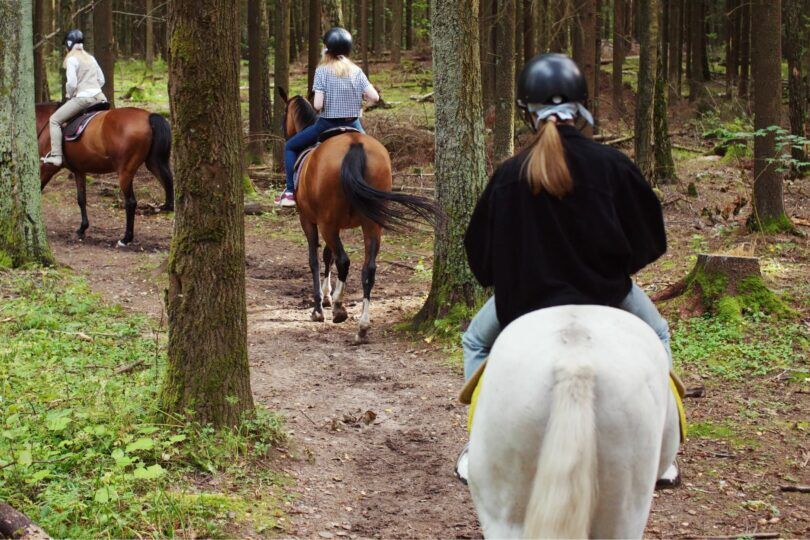
Mile Markers & Hoofprints
Horses were built more for distance than speed , although top racehorses have clocked speeds of up to 55 mph. But how far can (and should) a horse be asked to move in a single day?
Horses can travel anywhere from 10 to 100 miles in a day, depending on their age, breed, health, and level of fitness. The average horse can travel 25-40 miles in a day, whereas endurance horses can travel up to 100 miles a day for up to three days.
It’s important to take the time to get your horse in shape before attempting any longer or endurance rides.
Source: Canva
Equine Range
There’s a wide range of horse breeds in the world, and each excels at different things. Some horses could travel 10-20 miles in a day, others can travel up to 100 miles in a day.
The individual horse’s range depends on their age, breed, and level of fitness.
Horses in the Wild
Wild horses can cover 20-40 miles in a day in order to forage for sufficient food and water. They could potentially travel farther, but a lot of their traveling involves grazing, which slows them down.
The Importance of Fitness & Conditioning
It’s of paramount importance to take the time to get your horse in shape before attempting any long or arduous travel. It can take six to eight weeks to develop a basic level of fitness and years to get a horse in endurance-level shape.
Endurance-level shape equates to traveling up to 100 miles in one day
Equine Gaits and Their Speeds
The endurance horse.
Endurance horses are some of the fittest horses around. They can travel 50-100 miles a day in peak condition for up to three days (before needing a day or two to rest).
The Working Ranch Horse
Working ranch horses are powerhouses in their own rights, covering 20-25 miles each day with minimal strain.
The Carriage Horse
Carriage horses are sturdy and strong, capable of traveling 10-30 miles in a day.
How Far Can a Horse Travel…
Frequently asked questions, q: how far can a human travel in a day.
A healthy, fit human could travel 20-30 miles in a day.
Q: How far did cowboys travel on horseback?
On flat land, cowboys might cover anywhere from 30-40 miles in a day’s work. On hilly terrain, this distance may be reduced to 20-30 miles. If you were to transition to mountainous geographies, the average daily range reduces farther to 15-20 miles.
Q: How long does it take a horse to travel 100 miles?
The average, healthy horse can cover between 25 and 35 miles in a day, so it would take three to four days. A highly trained endurance horse could do 100 miles in a single day.
Q: How far can a horse travel without stopping?
If the horse is in great shape, he could reasonably cover 20-40 miles without stopping. Breaks are highly recommended, however, to allow for hydration and to prevent injury.
Q: How far can a horse travel in 3 hours?
Depending on his level of fitness and speed (walk, trot, canter, or gallop), a horse could travel anywhere from 12 to 30 miles.
Q: How far can a horse carriage travel in a day?
A carriage horse can travel between 10-30 miles in a day, depending on the horse, carriage weight, terrain, and weather.
Q: How long would it take to travel 1000 miles on horseback?
Depending on the horse and the terrain, it would take anywhere from 10 to 60 days to travel 1,000 miles.
Q: How far can a horse run with a rider?
Most in-shape horses could only gallop for a mile or two at a time or canter for five to seven miles at a time. A horse can carry a rider at a slower gait (like a walk or trot) for much longer.
Parting Thought
Whether you’re planning a horse-friendly camping trip or are considering trying your hand at an endurance event , rest assured your horse, with the right training, is more than capable of going the distance.
P.S. Enjoy this article? Trot on over to:
- Friendly & Fun: 4 Best Horse Breeds for Beginners
- How Much Horses Cost & How You Can Afford One
- 13 Best Boots for Horseback Riding Lessons
- 60 Questions to Ask When Buying the Horse of Your Dreams
- Horseback Riding: What to Wear (With Pictures)
- 8 Best Horse Riding Helmets for Hot Weather
- Horseback Riding Safety Equipment That’s Worth Every Penny
You may also like
Inside the equine mind: pursuing psychology, speaking their language: translating horse physiology..., love & let go: saying goodbye to your heart horse, safe vs. scared mindset, horse boarding basics (etiquette *everyone* should..., barefoot horses 101: why you *may* want to go barefoot, about the author, annakah stadlwieser.
Owner and equine photographer of Reversed Eye Photography, Annakah serves the the Edmonton, Canada area. She is happiest with her horse, behind a camera, or wandering in the forest. More than anything, she loves meeting horses and the people who love them and getting the chance to tell their stories through photographs!

How Far Can Horses Travel in a Day? (5 Things to Consider)
I don’t have as much time now, but I remember when I was younger I loved going on day-long trail rides with my horse. At the end of the day, I would wonder: how far did we go? How far can you travel by horseback in a day?
In this article, I’m going to answer all of your questions about how far a typical horse can travel in a day so you can plan your adventures accordingly!
If you’re interested in improving your riding skills on your trail rides (keeping pace, steering, having an emergency brake you can use if your horse bolts), check out my 100% FREE Beginner Rider’s Ebook: Click here to learn more!
How Many Miles Can a Horse Travel in a Day?
The short answer to the question is: it depends! Here are the factors to consider:
- The horse’s pace
- The terrain and footing you’re riding on
- The weather conditions
- Your horse’s fitness and physical ability
- Your ability as a rider
Knowing how far can you travel by horse in a day is essential if you plan on going on a fun trail adventure together, so let’s dive deeper into each of these considerations.
P.S. If you’re planning a long trip and need to get a saddle bag, check out our recommendations here!

The Pace of the Horse’s Travel
Understanding at what pace your horse moves will help in determining the amount of distance you cover and the time it takes to travel a certain distance in one day.
Generally, horses walk at an average speed per mile. A number of factors come into play when you go on a day-long journey with your trusty steed.
How Fast Are Horses?
A horse can go up to four miles per hour when it walks and typically travels somewhere between eight and 12 miles per hour at a trot.
At a canter, a fit horse can speed up anywhere between 12 and 15 miles per hour. At a gallop, they can travel between 25 and 30 miles per hour on average. Of course, a gallop can’t be sustained for very long and it’s unlikely the terrain will allow for a long gallop either.
Let’s Do The Math: On Average, How Long Can You Ride a Horse in a Day?
Typically, a healthy horse will comfortably walk for about eight hours.
By using the data above, that would mean that you could possibly cover about 32 miles . However, not many riders (especially those who aren’t used to riding long distances) can sit in the saddle for eight hours straight without getting very uncomfortable. If I tried to do that these days, I’d be so sore!
If you’re riding a more fit trained horse, it can occasionally trot or canter too, which can reduce the amount of time taken to cover certain mileage.
Existing Terrain and Footing
The estimated time and distance that we have given above is based on a healthy horse’s pace, riding without any form of interruption. But the second thing to consider when deciding how far an average horse will be able to travel is the terrain.
One reason that your horse could slow down or speed up depends on whether or not the riding conditions are favorable.
The terrain you travel on plays an important role in determining the distance you travel in a day. If your horse is not familiar or not comfortable with the terrain, your horse will tend to slow down to ensure safe footing and your travel time will be slower than expected.
When I went riding in Colorado, even though we were riding trained horses that were very comfortable with the steep hills and rocky passages, the horses still had to slow down in order to safely navigate the terrain.
Similarly, when we went for long rides in Arizona, we could canter and gallop across the flat plains, but then when we took trips up to the steep hills, we would travel much slower.
Navigating your horse through grounds that have steep hills means there is more stress on the horse’s limbs and cardiovascular system in comparison to when it travels on even ground.
If the terrain on which you’re traveling is hard and bumpy with lots of rocks, the impact on your horse’s hooves and joints will likely be more pronounced. If this happens, your pace will automatically go down in order to save your horse from any injury.
Additionally, traveling in areas that have sand or deep mud could also be a challenge for your horse.
Your horses’s tendons and ligaments would have to withstand more stress and exert more force to keep you moving.
In determining how far you can ride a horse in a day, you must always consider your riding path. The more stressful the terrain is, the slower your horse’s pace will be.

Weather Conditions
Always make sure you take weather conditions into consideration when planning your ride, too. If you haven’t ridden in poor weather before, you might not realize the extent to which weather can play a critical part when you are planning horseback rides, especially if you plan to ride the whole day.
Extreme weather can bring discomfort and, in worse cases, severe injuries or illness to your horse if they were to stumble, trip, or get too cold/hot.
Riding under the scorching heat of the sun is likely to affect your travel time, maybe even by a lot. When horses sweat, they tend to lose a large amount of water and electrolytes. That means if a horse gets dehydrated or runs severely low on electrolytes when you are traveling, the horse can suffer from health consequences that could be severe in nature.
Conversely, if your horse is subjected to extremely cold and windy weather without proper protective gear, they may not be eager to move. Cold weather can cause stiffening of muscles. The frozen ground can be stressful on hooves and joints. It can also worsen any underlying or old injuries.
If you do choose to take your horse on long periods of riding in bad weather, you may need to take frequent stops from riding in order to prevent serious injuries. This will in turn affect your potential travel time.
The Overall Fitness of Your Horse
Things like your horse’s breed and age can also affect how far they’re able to travel. Regular training and exercise will keep your horse healthy and fit. But some other factors can affect your horse’s overall fitness are out of your control.
It goes without saying that older horses may have a higher chance of having health issues such as arthritis. Aging horses may not be able to keep up with the speed you expect.
You should also consider any previous or current injuries and how they might affect your horse.
That said, you might be able to offset some fitness concerns by doing a few simple things:
- Ensure that you keep your pace reasonable so your horse does not get tired quickly.
- Make frequent stops to prevent exhaustion.
- Provide necessary riding equipment (this also includes food and water) for your horse to protect them during your journey.

I should also say that especially if you are planning a multi-day ride, it’s a good idea to take your horse to the vet (particularly if you haven’t been in a while). To know how far you can ride, you have to know exactly how fit your horse is. Your vet should be able to provide some insight on that and give you any recommendations or warnings.
Rider’s Fitness & Skill Level
Lastly, to go the distance, you must also make sure you are physically fit and capable as a rider. It’s not just the horse that needs to be skilled… If you’re not able to guide your horse over a puddle they find a little scary, you could be stuck in the same spot for a while!
You should train and exercise to build up your health and fitness . Make sure you are physically fit and well-rested. Having good focus and a clear mind will also help you get through your long journey ahead.
It is not wise for you to go straight to a whole day of horseback riding without trying a few easier trails first. Prior to your long adventure, try to do a few shorter trails. These shorter rides will help you get ready for longer ones.
You might be surprised how quickly you get saddle sore after half a day of riding or so, especially if you’re doing a fair amount of trotting!
Posts on Fitness & Flexibility For Riders You Might Like
For more guides on how to train as a rider, check out these articles:
- Ankle Mobilization Exercise & How To Keep Your Heels Down
- Complete Guide to Exercise for Riders
Posts on How to Improve Your Skill Level
- 10 Tips To Look Like A Pro On Your First Ride
- 10 Western Horseback Riding Tips for Beginners
- How to Move A Horse Forward Under Saddle
- How to Slow Down A Hot Horse
- The Secret Walk-to-Trot Riding Aid
- How to Sit the Trot
- How to Establish Neck Flexion
- How to Collect a Horse
- How to Ride Without Stirrups
- How to Stop a Bolting Horse
- How to Ask for the Canter
- How to Master Jumping While Minimizing Fall Risk
If you enjoyed this post, you might enjoy my FREE Beginner Rider’s EBook ! You’ll learn how to keep a consistent pace (whether you’re riding a fast or slow horse), how to make smoothened transitions, how to finally get the flexion and bend you want, The Emergency Brake as well as bonus chapters on making cantering and jumping so much easier!
Conclusion: How Far Can a Typical Horse Travel in a Day?
As you can see, determining the distance of how far your horse can travel in one single day is quite difficult.
There are a lot of factors to consider when determining how far you can travel by horseback in a day. To ensure that you travel as far as possible, make sure you get out on some practice rides to get you and your horse in shape!

There are so many physical and mental health benefits to trail riding, and it can be a great way to get out into nature and see the world. So get out there and enjoy it!
Happy riding!
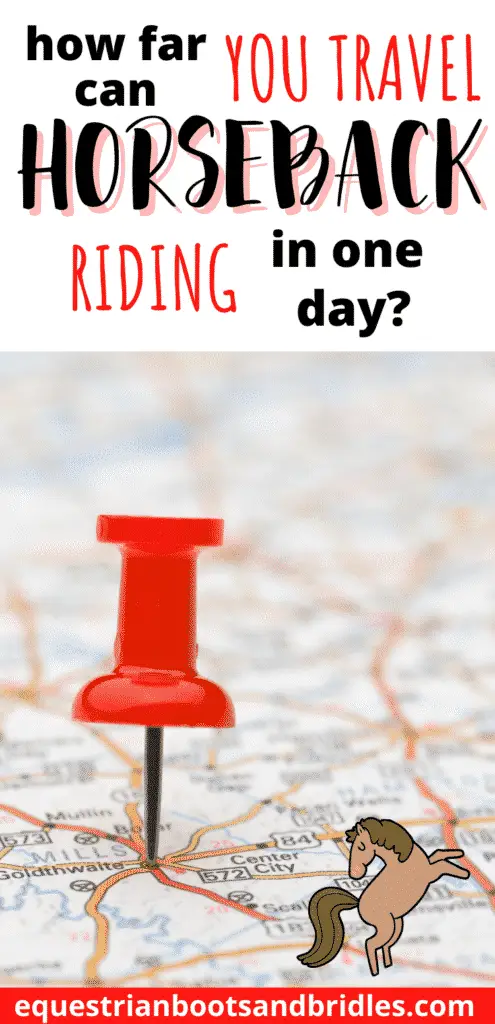
1 thought on “How Far Can Horses Travel in a Day? (5 Things to Consider)”
Yes, that’s right. I would also recommend starting with short distances, even if you are confident in your horse and she is super athletic.
Leave a Comment Cancel reply
This site uses Akismet to reduce spam. Learn how your comment data is processed .
Terms and Conditions - Privacy Policy


How Far Can A Horse Travel In A Day? The History On Travel By Horses & The Furthest Distances Achieved

Horses have great stamina and have the ability to travel for many miles in a day, but how far can they travel? When people traveled by horses in the past how far could they travel daily? I did some research on the history of horses and people and how they traveled.
How Far Can A Horse Travel In One Day?
Horses can travel many miles in the span of twenty-four hours. There is actually a competition that judges the horse on this called endurance riding. Endurance is a sport that judges the horse’s stamina and ability to go up to 100 miles in the course of one day. The record time for a horse to do 100 miles in one sitting is 5 hours and 45 minutes. Average horses can go around 35 miles in one day. The young and healthy horse, however, can travel between 50 and 75 miles in one day.
How Many Miles Can A Horse Go When Pulling A Carriage?
Traveling on the oregon trail.
Horses pulling covered wagons and carts along the Oregon trail were a common sight to see in the wilderness during the 1840s all the way through the 1860s.
These horses and people needed to travel through many different terrains from mountains to prairies, and even Native American territories.
On average, this long line of covered wagons only covered about 15 miles a day on average. This is probably why it took so long to journey from their original settlement all the way to Oregon.
Stagecoaches of the Wild West
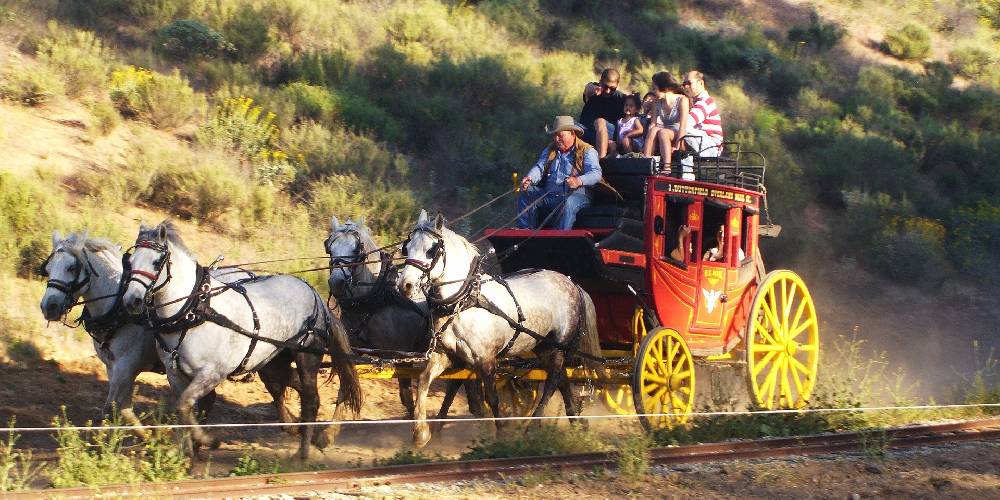
Stagecoaches were a form of transportation from town to town as well as a means of delivery and money transfer that started being used in the late 1850s. Stage coaches are large carriages typically pulled by a team of four to eight horses.
Stage coaches were pulled through several types of terrain and Native American territories. There are many stories of Native Americans attacking and raiding stage coaches. It was not entirely uncommon to have a stagecoach raided and robbed.
On average, horses that pulled stagecoaches could travel around 30 miles per day for each team. When coaches would get to a new town they would get a fresh team of horses and continue their journey so they weren’t wearing their first team out too much.
Traveling With An Average Carriage Horse
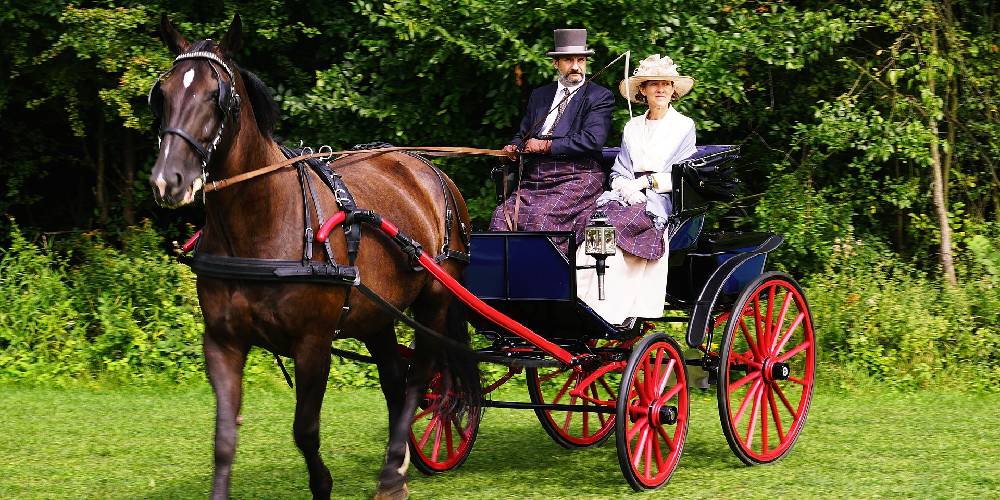
The carriage horse, or horse and buggy, were used for a very long time and only stopped being used around the 1920s. These horses were used to transport people and families to any destination they wanted to go.
These horses were only really used to travel up to 25 miles per day and rarely more than that. The horses that pulled these buggy’s and carriages were often owned and cared for by the family that used them, so the horses weren’t often overworked so they could serve the family longer.
How Far Can A Horse Travel With A Rider?
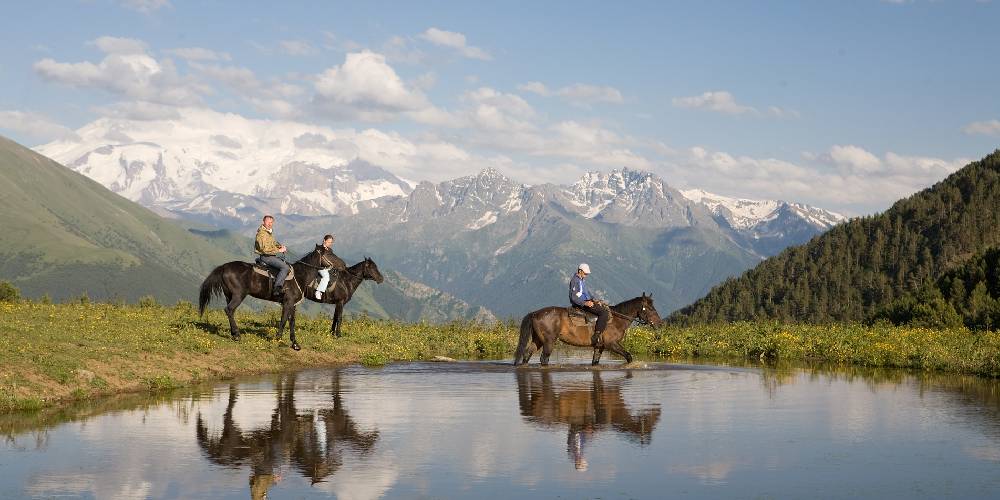
Usually, horses carrying a rider can travel around 50 miles in one day, but endurance horses, if moving for an entire day, can travel well over 100 miles.
Horses who carry a rider over many miles will tire faster than a horse who has no rider at all.
What Types Of Horses Can Travel The Furthest In A Day?
Hotblooded horses.
Hotblooded horses are horses that can travel the furthest in one day. Arabians are one hotblooded breed that can travel the greatest distance and are of the top choices for endurance horses.
It was actually an Arabian that traveled 100 miles in 5 hours and 45 minutes and achieved the record for the fastest 100 miles.
Another great option for a horse that can cover ground quickly and can keep moving for long periods of time is a Thoroughbred . These horses are used in racing for their incredible stamina making them an ideal choice for a riding horse that is needed to cover a great stretch of ground. Their tremendous speed makes them cover ground faster than most horses, as well as give them a great advantage over warmbloods regarding speed, energy, and stamina. The average horse of this breed can travel, with a rider astride them, up to 45 miles in one day. If the horse is very well taken care of and used for a stamina-required sport, they could travel well over 50 miles in a day.
Warmblooded Horses
Warmblooded horses are the next choice of horse for riding distances. Warm-bloods are often chosen as 3-day eventing horses because of their great stamina and jumping ability. These horses are heavier and often slower than their hotblooded cousins, but that doesn’t mean they can’t cover great distances.
Appaloosa horses are a breed that was bred and developed by the Nez Perce Native Americans. This warm blood is known for its stamina and durability as it was bred to be used and ridden in the wilderness of North America. This breed can easily cover up to 50 miles per day.
The Mustang is another breed that makes a great horse for traveling long distances. These hardy horses are actually the wild horses that roam all over America. This breed, because of its history in the wild, is used to constantly moving and can most likely cover around 50 or more miles in one day.
FAQs On The Distance A Horse Can Travel In A Day

What Breed Can Travel The Greatest Distance In A Day?
The Arabian.
Arabians have the best stamina and agility of any breed of horse. They are the best endurance horse that you could ever get. The Arabian is a breed that is full of energy making them able to keep going and going and going.
It is this breed that I can confidently say can travel the furthest of any other horse in one day.
Do Horses Need Breaks When They Are Traveling All Day?
Yes it is important that your horse has breaks.
Horses will need to re-hydrate during a long ride because if you are riding all day they are most likely going to be sweating. It is good to get off and let your horse rest from carrying you for so long. You can dismount and walk your horse for a mile or two before getting back on so the horse can relax and recover from the weight of you, the rider, on their back.
Can Horses Travel Further With A Rider Than When Pulling A Carriage?
Yes, horses can travel faster and further if they are just being ridden rather than pulling a cart or carriage. This is because pulling a heavy buggy, cart, or carriage is much more physically taxing than if the horse just needs to carry a person.
Hailey Sipila
Horses have been my passion ever since I can remember. At school, I was known as that weird horse girl, and I would read horse encyclopedias for fun. Over the years since those days, I have only learned more. My experiences with horses of a variety of breeds have taught me a lot. Now I want to share what I know with you!
Recent Posts
How to Tack Up a Horse: English Style
For those of you who are just starting to get into the horse world, or are just curious as to what all goes into riding and caring for horses, this is the place for you! As you may already know,...
Horse Names That Start with the Letter M
M has been wildly requested for horse names for some reason! Here are all my favorite horse names that start with the letter M! Female Horse Names Starting with the Letter M:...
A Comprehensive Journey into a Horse’s Daily Travel Range
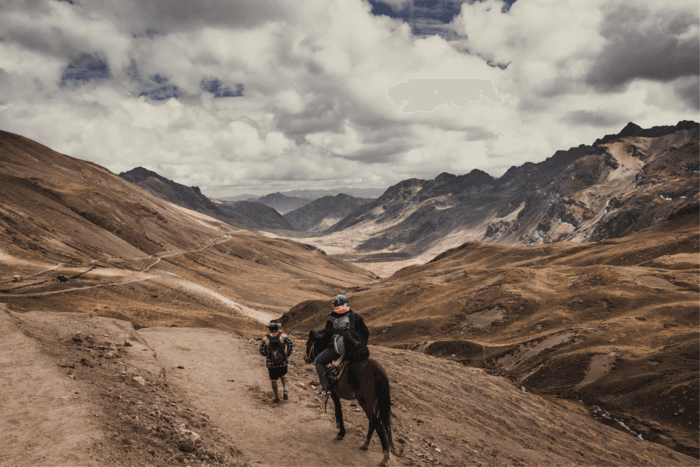
Introduction
From ancient warriors to modern adventurers, humans have relied on the horse to cover vast distances. These majestic creatures have been instrumental in shaping human history and civilization.
But, the burning question remains: how far can a horse travel in a day? To get an accurate answer, several influencing factors come into play.
Read More: How Much Does A Horse Weigh
Factors Affecting a Horse’s Travel Distance
1. breed and genetics.
Not all horses are built the same. Their genetics and breeding play a pivotal role in determining their stamina and speed.
- Thoroughbreds:
Primarily racehorses, they can sprint at astonishing speeds but may not maintain this for very long distances.
- Arabians:
Known for their stamina, they are the stars of endurance rides, capable of traveling longer distances without tiring quickly.
2. Age and Health
The age and health status of a horse play a direct role in its traveling capacity. A horse in its prime years with proper health care and nutrition will undoubtedly outperform an older or less healthy counterpart.
3. Training and Conditioning
Training is to a horse what regular exercise is to humans. A well-conditioned horse that undergoes routine training can handle long rides better than an untrained one.
- Routine Workouts:
Regular exercises such as trotting, cantering, and occasional sprints prepare the horse for longer journeys.
- Endurance Training:
Specialized training can boost a horse’s stamina, enabling it to cover greater distances without fatigue.
4. Terrain and Path
The type of path a horse treads can either aid or hinder its journey. While plains and flat terrains offer smoother rides, rocky or mountainous terrains present challenges.
- Smooth Terrains:
On flat terrains, a horse can maintain consistent speeds and cover more ground.
- Challenging Paths:
Difficult terrains require the horse to expend more energy, thereby reducing the distance it can travel.
Read More: Triple Crown Horse Races
5. Weight and Load
The amount of load a horse carries, including the rider and any additional packs, affects its endurance. The lighter the load, the easier it is for the horse to travel further.
6. Rest Periods and Pacing
Strategic breaks are crucial during long journeys. A horse pushed to its limits without adequate rest will not only cover lesser ground but may also risk severe health complications.
General Estimates of Travel Distance
Understanding the factors that influence a horse’s capacity to travel is one thing; putting it into numbers is another. Here are some ballpark figures:
- Average Riding Horse:
Typically covers 20-30 miles a day, moving at 3 to 4 miles an hour.
- Highly Trained Endurance Horse:
Such a horse can push the boundaries up to 50-60 miles, but it demands meticulous training and care.
- Pony Express Horses:
Riders would change horses every 10-15 miles, meaning an individual horse would cover this span at a swift pace before a switch.
Read More: How The World Looks From Horses Point of View
Ensuring a Safe Journey for the Horse
For those eager to embark on long rides, horse welfare should always be the top priority.
1. Proper Saddling:
A well-fitted saddle can make a world of difference. It should be comfortable for both the horse and rider, minimizing chances of chaffing or pressure sores.
2. Regular Check-ups:
Consistently monitor your horse during the ride. Signs of fatigue, dehydration, or any discomfort should be addressed immediately.
3. Hydration and Nutrition:
Hydration is crucial. Horses may consume 5-10 gallons of water per day, and this figure can spike in hotter climates. Also, ensure they have access to quality feed to replenish their energy.
4. Foot Care:
A horse’s hooves are its foundation. Regular hoof checks, proper shoeing, and care can stave off potential injuries and discomforts.
Read More: What do Horses do All Day and All Night
Historical and Cultural Context
The tapestry of human history is embroidered with tales of horse-led expeditions. Knowing how far a horse can travel in a day wasn’t just a trivial fact but a strategic advantage.
- Empires and Horses:
From Genghis Khan’s swift messengers that connected the vast Mongol Empire to knights in medieval Europe, the horse was a key player in communication and warfare.
- Cultural Impact:
In many cultures, the horse is a symbol of freedom, strength, and loyalty. Their ability to travel vast distances with humans has cemented their place in folklore, history, and our hearts.
The magnificent horse, with its strength and endurance, has been an integral partner to humans throughout history, enabling us to explore, conquer, and connect diverse terrains and cultures.
The distance a horse can travel in a day is influenced by a blend of factors from breed and conditioning to the paths they tread and the care they receive. While averages and estimates provide a guideline, each horse, like every individual, has its unique capabilities and limits.
As equestrian enthusiasts, adventurers, or casual riders, our responsibility lies not just in marveling at these distances but ensuring that every mile tread is done with the horse’s welfare at heart.
Whether you’re preparing for a cross-country trail or a short journey across a pasture, understanding your horse, respecting its needs, and investing in its care are the true markers of a successful ride.
In this timeless partnership between human and horse, it’s the journey together that truly matters, far more than the miles covered. As we saddle up and venture forth, let’s carry forward a legacy of respect, understanding, and mutual trust with these incredible creatures that have shaped so much of our shared history.
1. How fast can a horse run?
Depending on the breed and conditioning, a horse can gallop at speeds ranging from 27-40 mph. However, this speed isn’t sustainable for extended periods.
2. What’s the longest recorded distance a horse has traveled in one day?
There have been instances in endurance races where horses have covered over 100 miles in a day. However, these are exceptional cases with top-tier horses and aren’t the norm.
3. How can I prepare my horse for a long journey?
Preparation should encompass proper training, nutrition, health checks, and acclimatization to the expected terrains.
4. Are there specific breeds better suited for long-distance travel?
Yes, breeds like Arabians are renowned for their endurance and are often preferred choices for lengthy journeys.
Leave a Comment Cancel reply
Save my name, email, and website in this browser for the next time I comment.

How Far Can A Horse Travel In A Day?
As an Amazon Associate we earn from qualifying purchases.
Horses are remarkable animals and are known for their incredible endurance and speed. But when it comes to travel distance, just how far can a horse travel in a day?
Table of Contents
So How Far Can A Horse Travel In A Day?
The answer depends on a variety of factors, including the horse’s age, breed, and fitness level. Generally, a healthy and fit horse can travel up to 20 miles in one day. However, this distance can be increased if the horse is used to long-distance riding and is in peak physical condition. A horse that is trained for long-distance riding can travel up to 30 miles in a single day, while a horse that is used to carrying a rider and baggage can travel up to 40 miles.
Horses can also travel faster if they are carrying a light load and if the terrain is flat. For example, a horse can travel up to 30 miles per hour on a flat surface with a light load.
The amount of time that it takes for a horse to cover a certain distance also depends on the terrain. For example, a horse can cover a 10-mile distance over a flat surface in approximately one hour, while it will take approximately two hours to cover the same distance on mountainous terrain.
In addition to the distance and speed, the length of time that a horse can travel in a day also depends on its fitness level and the terrain. A horse that is in peak physical condition and used to long-distance riding can travel for up to 8 hours in a single day. However, this time can be reduced if the terrain is challenging and if the horse is not used to long-distance riding.
To ensure that a horse is able to travel safely and comfortably for long distances, it is important to provide it with proper nutrition and care. Regular exercise, proper hydration, and access to rest stops are also essential for a horse to be able to cover long distances in a single day.
In conclusion, the distance that a horse can travel in a single day depends on a variety of factors, including the horse’s age, breed, and fitness level. Generally, a healthy and fit horse can travel up to 20 miles in one day, while a horse that is trained for long-distance riding can travel up to 30 miles. With proper care and nutrition, a horse can cover long distances in a single day, with some horses capable of traveling up to 40 miles.
How Long Can A Horse Live With EPM? What is EPM in Horses?
How Far Can A Horse Travel In A Day With A Carriage?
A horse-drawn carriage can travel up to about 25 miles in a day, depending on the terrain, the weight of the carriage, and the strength and endurance of the horse. On flat terrain, with a light carriage and a strong horse, a horse-drawn carriage could travel as many as 30 miles in a day. However, if the terrain is hilly, the weight of the carriage is heavy, or the horse is not particularly strong, the distance a horse-drawn carriage can travel in a day could be as low as 10 miles.
How Far Can A Horse Travel In A Day Running

A horse can typically run for up to 25 miles in a single day, depending on its fitness level and the terrain. The horse’s speed and endurance will also be affected by the environment, temperature, and the type of terrain it is running on. Generally, horses can maintain a steady pace of about 5mph for a prolonged period of time. Over longer distances, horses can reach speeds of up to 25mph, but this will depend on the horse’s physical condition, the terrain, and the environment. Generally, a horse should rest for a few hours between long runs, allowing them to recover and refuel.
Does Reining Hurt Horses? The Sad Truth
How Far Can A Horse Travel In A Day? Final Thoughts
Answering the question of how far a horse can travel in a day is a tricky one. It depends on a variety of factors, such as the horse’s age, breed, and overall health and fitness. As such, it would be difficult to pinpoint an exact number.
Beyond that, the amount of time and terrain the horse covers also play a big role. For instance, a horse might be able to cover more distance on flat terrain during a longer period of time compared to a hilly landscape in a shorter amount of time. Additionally, the horse’s rider or handler will likely factor into the equation as well, as their experience and skill level can affect the horse’s performance. All these variables make it hard to answer how far a horse can travel in a day.
For more information on long distance horse riding follow this link.
Amazon and the Amazon logo are trademarks of Amazon.com, Inc, or its affiliates.

Hey there, I’m Jasmine! I’m a total horse fanatic and have been working with these amazing animals for as long as I can remember. I’m passionate about sharing my love for horses with others and helping them learn more about these majestic creatures. As a professional horse trainer and riding instructor, I’ve developed a deep understanding of equine science and am committed to the welfare of horses. That’s why I founded OwnTheHorse.com, a blog where I share my knowledge and insights with fellow horse enthusiasts. I love connecting with my readers and building a friendly community of horse lovers. Whether you’re a seasoned equestrian or just starting out, I’m here to help and inspire you. Above all, I’m a friendly and compassionate person who truly cares about the well-being of horses and their human companions.
Related posts:
- Top 3 Best Buddy Saddles Reviewed
- Can Horses Eat Carrots? Here’s What You Need To Know
- The 5 Best Saddles for Arabian Horses
- Can Horses Eat Blueberries?
Didn't find what you need? Use the search!
Pet Keen is reader-supported. When you buy via links on our site, we may earn an affiliate commission at no cost to you. Learn more .
How Far Can a Horse Travel in a Day? The Interesting Answer
Have you ever wondered how far can a horse travel in a day? Many factors will determine the final figure, including the horse’s size, breed, and age. The location and therefore, the environmental and physical demands of the area also play a massive part in determining how far a horse can travel, as well as if the horse is carrying a rider or pulling a load.
It can be a difficult question to answer, but if you’re planning a day on the trail, intend to compete with your horse, or are trekking on any journey and want to be sure you can cover the distance, it is useful to know how far a horse can travel in one day.
On average, a horse can be ridden between 25 and 35 miles in a day, with the typical distance being closer to the bottom of this range.
- Today’s Horses
It is worth bearing in mind that the way that we use horses today is different from how we used them hundreds of years ago. We have cars and other vehicles that will carry us and our goods over long distances.
This means we no longer rely on horses to make long and arduous journeys every single day. As such, while horses were once trained and conditioned to complete exceptional treks and journeys every single day, they are less capable of doing so today. There are a few exceptions, however, and you can see them in endurance races.
While today’s horse will travel around 25 miles, the horse of yesteryear would have been better able to travel 35 miles.
- One-Off vs. Daily Commute
A horse might be able to complete a 30-mile journey today but will require one or several days to recover from this feat. If you want to travel hundreds of miles over several days, you would be better off asking your horse to complete around 15 miles each day. This will also be easier on you, your back, and the rest of your body.
- Athletic Conditioning
The more often a horse completes a long journey, the better equipped they will be to do it again. Horses can benefit from athletic conditioning in the same way that people can. This is especially true of endurance and competitive horses . Follow a professional training schedule, and you can greatly improve the distance that your horse can travel.
An endurance race can last 24 to 30 hours and cover between 50 and 200 miles in total, but these are extreme distances that are comparable to an ultra-marathon runner completing a 100-mile run.
Most horses prefer moderate ground under their feet—nothing too wet and boggy or too dry and hard. This enables them to keep going, and it will prevent their muscles from getting sore and injuries from occurring. Anything other than these optimal conditions means your horse will cover less ground.
Besides ground conditions, horses prefer certain weather conditions. Like humans, they will become exhausted more quickly in the hot sun, though some horses that have been bred in these conditions may prefer hot conditions to cold, wet, and windy ones.
Ill-fitting saddles or an ill-fitting bridle can cause discomfort and pain to your horse. This will mean your ride cannot cover the same distance that they might otherwise would have. Losing a shoe will inevitably mean your day’s riding is over, and it could greatly reduce the distance that you cover. Ensure that your horse’s equipment is properly maintained to minimize the risk of injury and the likelihood of having to cut your day short.
- Rider Hardiness
While the athleticism, strength, and endurance of your horse are obviously important in determining the daily distance that they can cover, so too is your own hardiness. Riding a horse for 6 hours at once is painful and tiring, and even experienced riders struggle to stay in the saddle for an entire day. While your horse might be able to cover 30 miles, you might have to call it after 10.
Taking all these factors into account, it is fair to say that the average horse and rider can travel between 15 and 20 miles a day. It is exceptional and rare for one to be able to cover more than 30 miles in 24 hours, and even this length of journey would be a one-off trip, requiring several days’ rest afterward, and they would need to be in perfect weather and geographical conditions. Also, you and your horse would need to be conditioned for the journey and have the proper equipment.
Related Horse Reads:
- 6 Beautiful Horse Mane Styles You Can Do Yourself (With Pictures)
- 10 Most Exotic Horse Breeds (With Pictures)
- 5 DIY Horse Jumps You Can Build Today (With Pictures)
Featured Image Credit: Pixabay
Oliver Jones
Oliver (Ollie) Jones - A zoologist and freelance writer living in South Australia with his partner Alex, their dog Pepper, and their cat Steve (who declined to be pictured). Ollie, originally from the USA, holds his master's degree in wildlife biology and moved to Australia to pursue his career and passion but has found a new love for working online and writing about animals of all types.
Related articles
11 diy horse stall plans you can make today (with pictures), how to teach a horse to lay down in 5 simple steps, how old should a horse be before riding facts & tips, is horse insurance worth it what you need to know.
Search our database of over 16755 posts with up-to-date information from our experts and veterinarians.
Want to talk to a vet online?
Whether you have concerns about your dog, cat, or other pet, trained vets have the answers!

National Equine
How Far Can A Horse Travel In A Day?
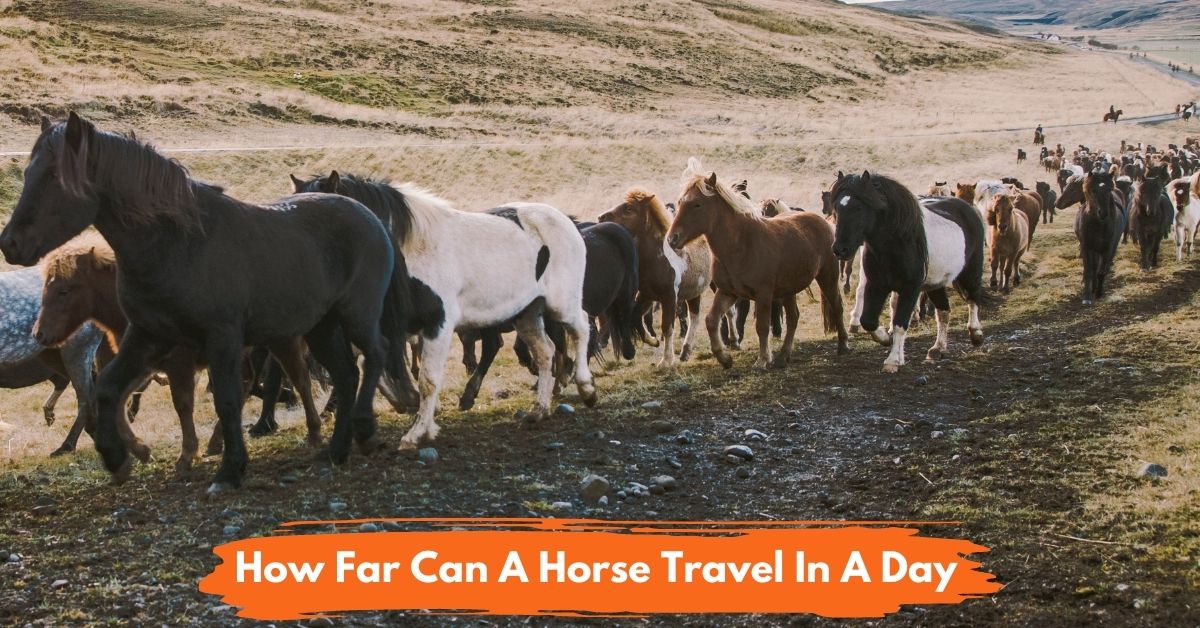
How far can an average horse travel within a day? As long as your horse walks or trots, you can ride your horse from 25 to 35 miles (40 to 56.5 kilometers) without resting.
A trail horse is best for traveling long distances. Trail horses in good shape can withstand long journeys from 50 to 100 miles (80.5 to 161 kilometers) in a day.
Other breeds that can travel long distances include the Saddlebred and Icelandic horse . These horses have a natural, smooth gait that is easy on the rider and horse alike.
If you plan to ride your horse long distances, it’s important to have the right information. You might not know if your horse is going to hold up or if you’re going to run into any unforeseen problems.
This article will go over essential topics that need discussion about the topic.

How Far (Miles) Can a Horse Travel in One Day?
Horses are strong and capable animals that can travel long distances, but the exact distance they can travel in one day depends on a variety of factors, including the horse’s age, breed, physical condition, and the terrain it is traveling on.
In general, a healthy adult horse in good physical condition can travel between 20 and 40 miles (32 and 64 kilometers) in a single day. This distance can vary depending on the type of terrain the horse is traveling on, as well as the weather conditions. For example, a horse may be able to travel farther on flat terrain in cool weather than it could on hilly or rough terrain in hot or humid conditions.
Age and physical condition can also affect a horse’s travel distance. Younger, healthier horses may be able to travel longer distances than older or less fit horses.
It is important to take these factors into consideration when planning a long journey and to provide the necessary rest and care for the horse along the way. This includes providing the horse with plenty of water, food, and rest breaks to ensure that it stays hydrated, nourished, and comfortable throughout the journey.
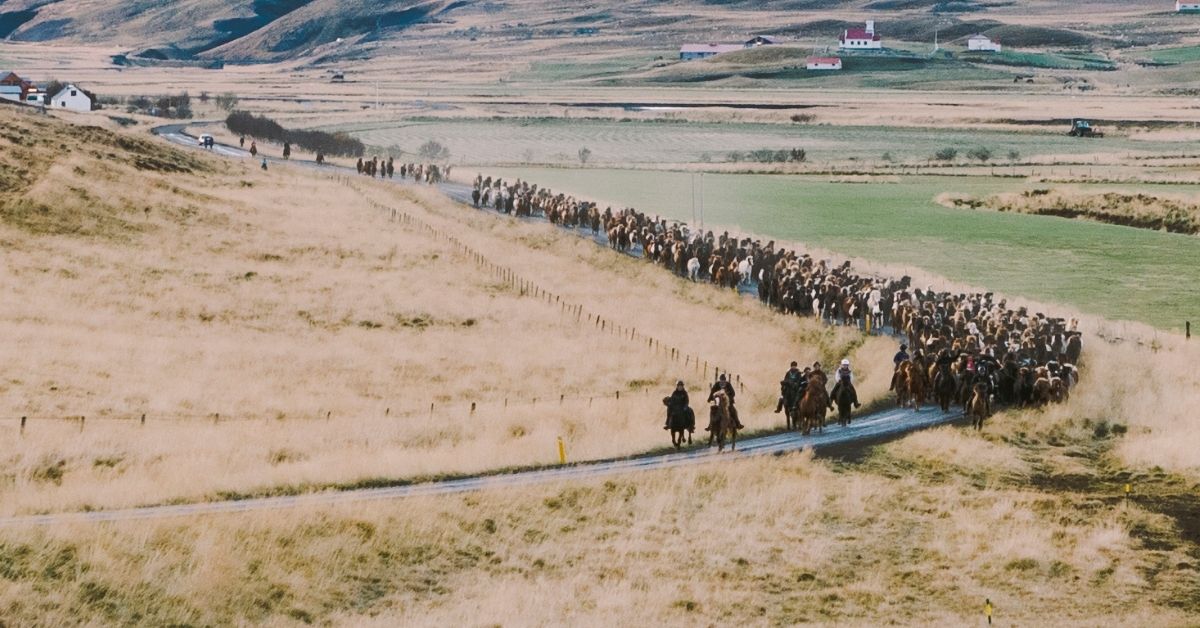
What Factors Affect How Far a Horse Can Run?
There are tons of factors that can affect how far a horse can run in a day. Here are some factors that can impact on your horse’s performance during a day-long trip:
Picking the Pace
How fast you go will play a big role in how long your horse can keep going. If you want to travel further, it’s best to go slower so your horse can last longer.
While the pace might be slower, it doesn’t mean that the journey will take any longer. In fact, going at a moderate pace might get you there faster since your horse won’t get as tired.
When it comes to pacing, you start by gaining a bit of momentum. Find a comfortable pace to cruise at, and finally, ease up on the gas a bit as you’re getting close to your destination.
Generally, a lateral two-beat gait like the jog or trot is best for long-distance travel.
You can include canters and gallops to make the travel efficient. But make sure not to go too crazy with the galloping since it can tire out your horse.
Traveling on Different Terrains
Another factor that plays a role in how far your horse can travel is the type of terrain you’re on. The surface your horse walks on makes a world of difference.
For example, going uphill is obviously harder on your horse than going downhill. That’s because going uphill puts more muscle strain, which can quickly lead to fatigue.
The same goes for different types of surfaces. For example, if you’re traveling on soft and muddy trails, your horse will have to work harder than on a packed trail.
The mud and soft ground can make it difficult to balance and move forward. This is especially troublesome if your horse is carrying more load.
The type of terrain can also affect the pace of your travel. If the terrain is more difficult, you might have to slow down to make it easier on your horse.
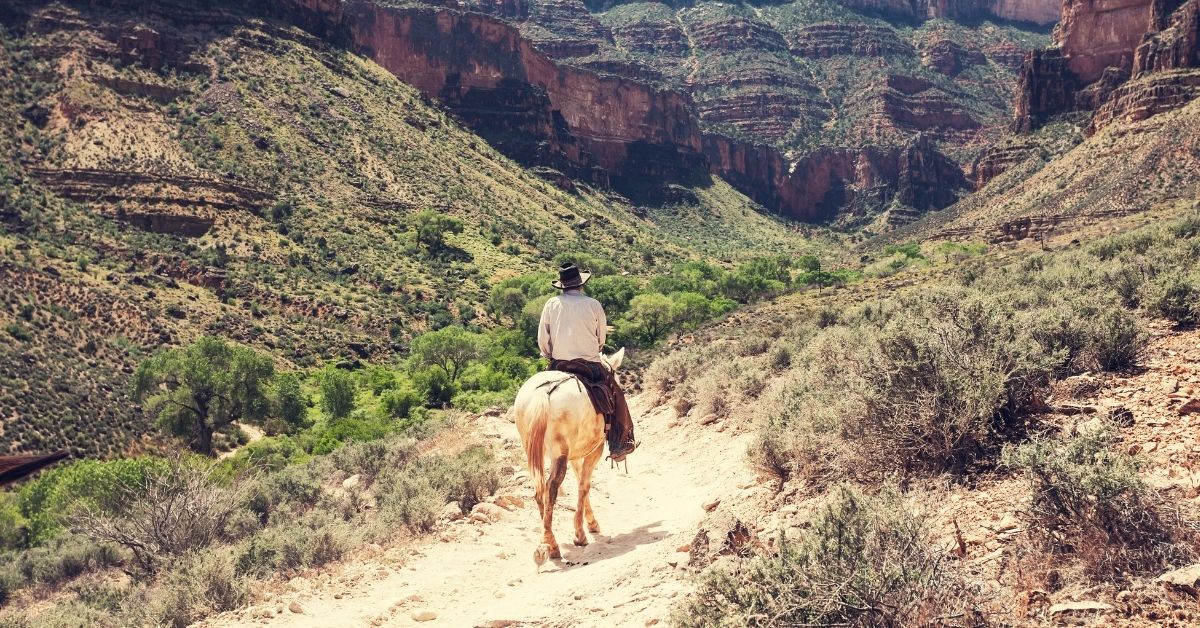
Weather Conditions
The weather can also play a role in how far your horse can travel. If it’s scorching hot outside, your horse will get tired much faster. That’s because they’ll work harder to stay cool and lose more water through sweating.
If it’s cold out, your horse might have a harder time getting warmed up. As a result, your horse will need to spend more energy to maintain its body temperature.
Be aware of potential weather conditions that might make travel more difficult. For example, high winds or heavy rain can make travel challenging (and even dangerous).
If the weather is bad, it’s best to wait it out or find shelter. Avoid pushing forward and risk getting stranded or lost.
Horse’s Health and Fitness
If you’re going to ride your horse all day long, make sure they’re in good health and condition for the journey. A horse that’s not used to being ridden for long periods will get tired much faster than a horse that’s used to it.
That’s why it’s important to increase the amount of time you spend riding each day. But, if you try to do too much too soon, you might end up overworking your horse. As a result, you could end up with an injured or sick animal.
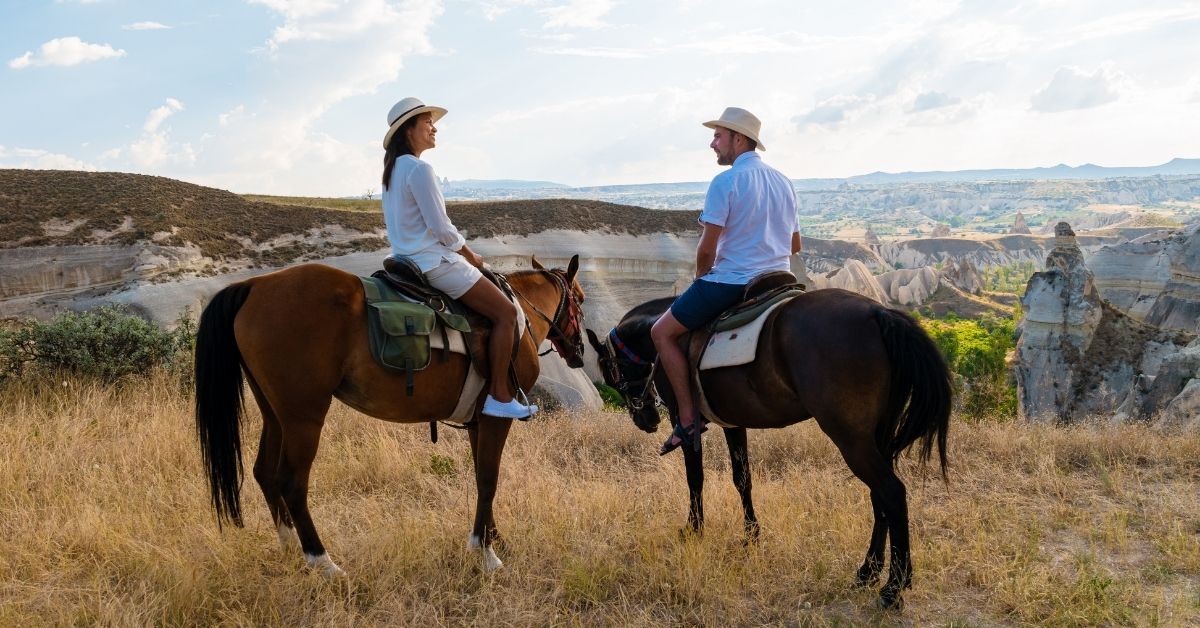
Proper Equipment for the Horse
There’s also the matter of having the right equipment for your horse. If you’re carrying a lot of gear, you might need to get a pack-saddle or panniers to help distribute the weight. Otherwise, your horse could end up with sore muscles or back problems.
Ensure that your saddle fits properly and isn’t causing any discomfort for your horse. For example, an ill-fitting saddle can rub and chafe the skin, which can be painful and lead to saddle sores.
It’s also important to have the right footwear for your horse. If you’re riding on rough terrain, you might need hoof boots to protect your feet. Otherwise, they could end up with painful cracks or chips in their hooves.
Conditioning for a Riding Discipline
If you’re planning on doing a lot of long-distance riding, it’s important to ensure that you and your horse are ready for it.
Spend some time conditioning your horse to ensure it can handle the demands of long-distance or prolonged riding. This can include working on their endurance by doing things like trail riding or trailering.
You should also ensure that you’re in good shape before you embark on a long journey. After all, you’re going to be spending a lot of time in the saddle, so you need to be able to handle it. That means being physically fit and having a good level of endurance.
Feed and Water
Finally, make sure you have an ample supply of food and water for your horse. If you’re going to be riding all day, you must ensure that your horse has enough to eat and drink.
You should bring along hay or grain and water buckets and regularly stop to let your horse rest. You can also consider stopping by natural food and water sources to let your horse drink and cool off. It’s a great option to travel as lightly as possible.
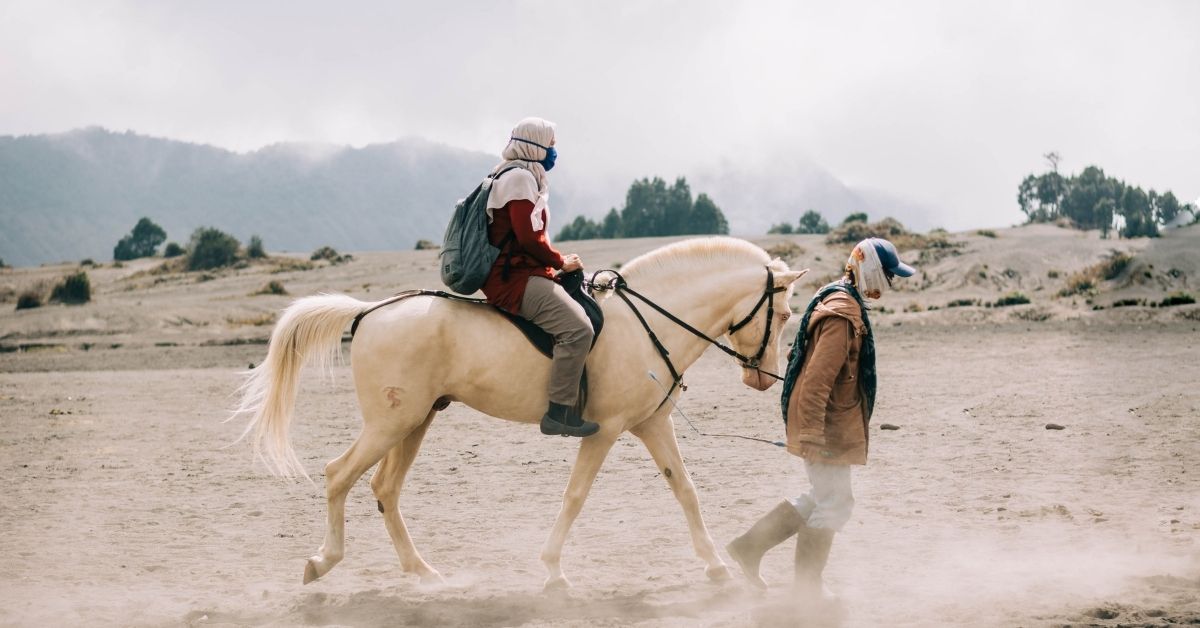
Best Endurance Horse Breeds
Different horse breeds specialize in different things. Some are better at sprinting, while others have more endurance. If you’re looking for a horse that can fulfill the latter, I’ve listed the top four best breeds for the job:
Arabian Horse
When it comes to endurance, the Arabian horse is king. These horses are known for their stamina and have been used in long-distance travel for centuries. They’re also relatively small, which makes them easier to transport when needed.
Arabian horses are also known for their intelligence, which can be helpful when spending long hours in the saddle. They’re also relatively easy to train, which is another bonus.
Mustang Horse
Mustang horses are more than just beauty — they’re also incredibly hardy. These horses are also known for their endurance and ability to survive in harsh conditions.
Mustang horses were originally bred in the American West and have been used by cowboys and ranchers for centuries. They’re also one of the most popular horse breeds for long-distance riders.
Morgan Horse
The Morgan horse is another solid choice for endurance riding. These horses are known for their versatility, strength, and stamina.
They were originally bred in Vermont and used for various tasks, including farming, logging, and even racing. Today, they’re still used for various disciplines and make great all-around horses.
The versatility of the Morgan horse means that it can be used for various riding styles. If you’re looking for a horse that can do it all—including one that can travel long distances—then the Morgan horse is a great option.
Anglo-Arabian Horse
Any breed that mixes with the Arabian will be a good choice for endurance riding. After all, the Arabian horse is known for dominating the endurance racing sport.
However, I’d like to put the Anglo-Arabian in its own category. These horses are a mix of Arabian and Thoroughbred horses, which makes for a perfect combination of speed and stamina.
The Anglo-Arabian Horses have the physical features of a Thoroughbred. At the same time, it will also have the elegance and high endurance of the Arabian.
With both genes, the Anglo-Arabian horse benefits in both facets.
Frequently Asked Questions
Got some more things in mind? I get it—traveling with a horse can be daunting. So, to help put your mind at ease, I’ve answered some frequently asked questions about long-distance riding below.
How Far Can a Horse-Drawn Carriage Travel in One Day?
According to research, a horse-drawn wagon or carriage can travel between 10 to 30 miles (16 to 48 kilometers) daily. However, this will depend on the terrain, the load’s weight, and the horse’s condition.
If you want to ensure your horse-drawn carriage lasts the entire period, it’s important to take breaks and let the horse rest. You should also have enough nourishment to keep your horse going despite the circumstances.
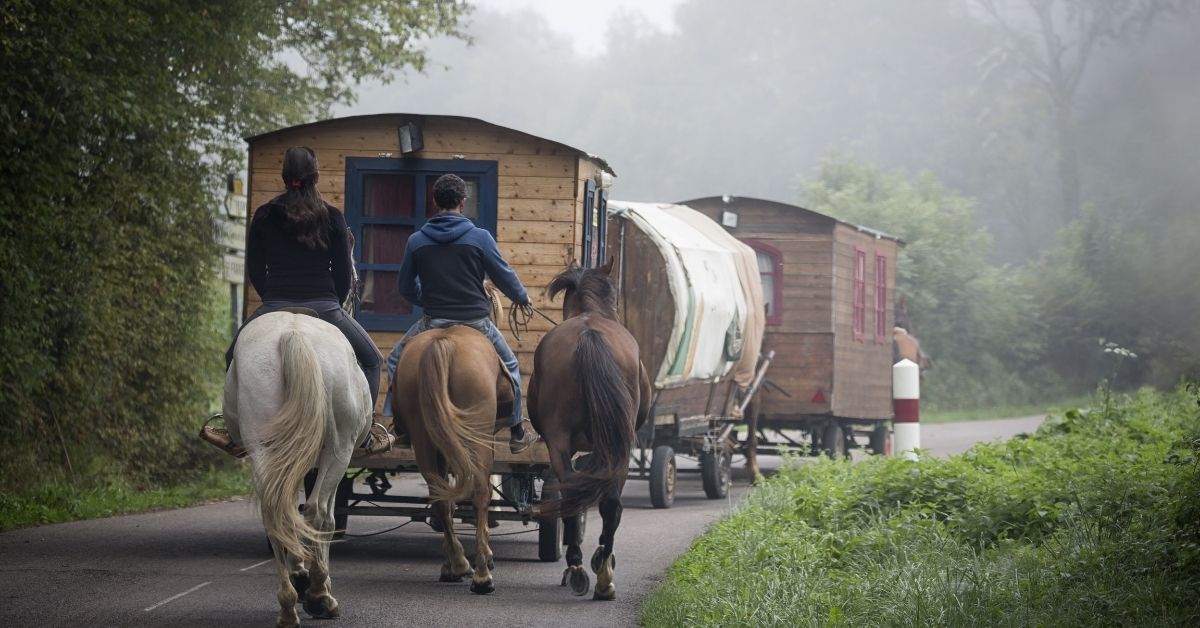
How Far Can Horses Travel in One Day with a Rider?
Horses tend to run efficiently on their own for longer distances and periods. On average, a horse can travel up to 50-plus miles in one day.
However, the distance will be significantly less when you factor in a rider. Generally, a horse can only travel 25 to 35 miles (40 to 56.5 kilometers) with a rider on its back.
Other factors that can affect the distance include the weight of the rider, the terrain, and the horse’s condition. So, if you think you and your horse can handle it, go for it!
How Far Can a Horse Jump?
Horses are capable of jumping impressive heights and distances, and their jumping ability can vary depending on their breed, size, and training.
In general, a horse can jump up to around 5 feet (1.5 meters) high and 15 feet (4.5 meters) long. However, some horses are able to jump even higher and farther, with some show jumpers and eventers regularly clearing heights of up to 6 feet (1.8 meters) and distances of up to 20 feet (6 meters) or more.
It’s important to note that not all horses are able to jump to these heights and distances, and it takes a lot of training and conditioning to build a horse’s jumping ability.
Jumping also puts a lot of strain on a horse’s legs and body, so it’s important to make sure that a horse is properly trained and conditioned before attempting to jump high or far.
How Far Can a Horse Swim?
Horses are not only expert jumpers but strong swimmers as well. They can swim for long periods and cover a lot of distances.
A horse can swim for approximately 30 minutes until it suffers from exhaustion. However, a physically fit and in excellent health horse can swim for an extensive period of time.
On average, horses can swim for approximately one mile before taking a break. It’s important to note that the distance will depend on the current, the water’s temperature, and the horse’s condition.
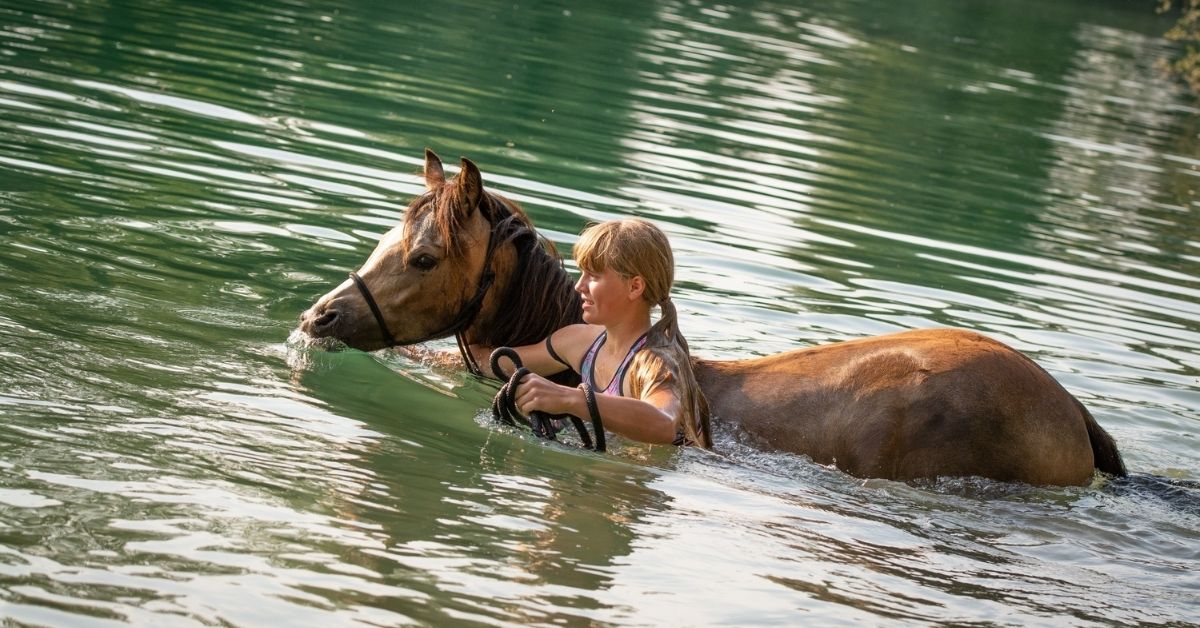
How Far Can a Horse See?
Horses have significant eyesight and can see for long distances. On average, a horse’s range of vision is approximately 300 degrees, much wider than a human’s 180-degree field of vision.
This level of vision allows horses to see up to 30 feet away. In addition, horses can see in color and have a better sense of night vision than humans.
Also, horses can see in low-light conditions and have excellent night vision. In fact, horses can see six times better than humans in low-light conditions and three times better in complete darkness.
Final Thoughts
There’s no doubt that horses are amazing creatures. Not only can they travel long distances, but they can also swim and jump to great heights.
It’s no wonder why horses have been used for transportation and travel for centuries. They’re pretty efficient when it comes to covering a lot of ground!
I hope this article answers your question and sheds some light on how far horses can travel in a day.
Leave a Comment Cancel reply
Save my name, email, and website in this browser for the next time I comment.

How Far Can A Horse Travel In A Day?
If you’re thinking about trail riding or taking your horse on a leisurely ride, you might wonder just how far they can travel in the space of a day.
Horses are resilient animals that can travel long distances in a day when necessary. However, their actual range of travel is usually only 20 to 50 miles per day. Some breeds can travel considerably more but, even they cannot travel more than 70 or 80 miles per day without a rest period.
A lot of factors will determine how far your horse will be able to travel in a day. Some of these factors include:
- The fitness and condition of your horse.
- The speed you plan on traveling.
- Weather conditions.
- The age of your horse.
- Your physical condition.
- The terrain.
We will talk about some of the things you need to keep in mind before embarking on endurance riding , trail riding, or just a normal long ride.
Table of Contents
How fast are you planning on going?
Evidently, the pace you choose will greatly determine just how far a horse will be able to cover in a day.
Normally, a horse will be able to walk close to four miles an hour. Trotting will cover approximately eight to twelve miles while a horse will be able to go twelve to fifteen miles in an hour at a canter. However, a galloping horse can be able to cover 25 or even 30 miles in an hour.
If the distance is a lengthy one, you naturally will not maintain the same speed for the entire journey. This will be very tiring for yourself and your horse – even if your horse is walking.

On a general note, if a horse is walking, it will be comfortable doing just this for approximately eight hours. What this means is that in a day of eight hours, your horse will be able to cover close to 32 miles while walking.
How does the trail look like?
The intended terrain is an incredibly important consideration to determine just how far the horse will be able to cover in a day. With muddy weather, the journey will definitely be slowed down as it will be more difficult for the horse. Also, walking on the sandy ground will be hard on the tendons and ligaments of your horse.
In the event that you have to climb steep hills, both you and the horse will undoubtedly become tired. In addition to this, having to climb up and down a hill will take its toll on the cardiovascular system of your horse.
Your horse might also suffer injuries to the hooves and joints if they navigate rocky and hard terrains. This discomfort will also be felt by you on the saddle. That’s why it is imperative that you try not to pass through rocky areas.
How about the weather?
This is another essential factor in long journeys. This is because the horse may end up losing so many electrolytes and hydration through sweat. Horses, just like people, may suffer heat stroke or other health challenges when they’re dehydrated or their electrolyte level is depleted.
You should make sure that you make regular stops if the weather is very hot.
Make sure that your horse has the freedom to take water during the journey. If it’s an extremely hot day then ensure that you add electrolytes. You can do this by just putting an electrolyte supplement in the water or pouring Gatorade in the water.
During a hot but windy day with low humidity, your horse might sweat a lot, but because of the wind, the sweat may quickly evaporate. This might be very misleading and you’d think your horse isn’t sweating a lot. That’s why you need to monitor them at intervals to know their condition.
How often do you recharge?
Normally, during hot weather, you ought to ensure that your horse has enough to drink as well as enough electrolytes to be in good condition. This should also apply to you.
Each time you embark on a long journey, try to make period stops so that your horse will be able to graze and drink water.
You should be concerned if your horse refuses to drink or loses its appetite altogether. Any of these signs might prove that your horse has become exhausted or even worse. These signs should tell you that you have to stop riding the horse.
The fitness of you and your horse
If you only go on occasional rides with your horse, you naturally will not be comfortable enough to go on a long ride with them. Your horse will start to tire and you will become quite sore.

However, if you regularly take rides with your horse, you will likely be able to cover more ground in a day. One sure way to achieve this is if trotting, centering, and walking are alternated.
The level of training you and your horse have undergone is really the main factor that will determine just how far you will be able to go in a day.
It is absolutely important that you don’t embark on a long journey with a horse in poor condition. If you plan on long rides, you have to ensure that you and your horse are in top shape to endure throughout the trip.
When embarking on a trail ride, the relationship between you and your horse is very important. You should be able to recognize when your horse is starting to get tired. Make sure that they don’t over-exert themselves. This is because tired horses, just like human beings, can become less focused which can lead to accidents.
How about equipment?
The performance of your horse can be adversely affected if you have the wrong equipment with you. This can also cause you discomfort and even lead to your horse getting injured. Ensure that your bridle and saddle are well fitted and are also in proper condition before you begin the long ride.
It is also important to consider the condition of the hooves of your horse.
It is advisable that your horse visits a farrier for an examination and trim once every two months. If you plan on going for trail rides, it is definitely a good idea to get horse boots that have been well-fitted to ensure your horse’s soles and hoof walls are protected.


How Far Can A Horse Run Without Stopping, How Far, How Long?
We’ve all grown up watching movies of cowboys racing their horses across open fields for miles without end, but how far can a horse really gallop without stopping? And how far can horses realistically travel in a day? The answer is nearly never the same and for a good reason. In this article, we will discuss the aspects relating to horse endurance and speed in depth.
How far can a horse travel in a day? Walking steadily, a horse can travel about 20 and 30 miles a day, with an average of 25 miles per day. You might think a galloping horse can travel more miles in a day, but a galloping horse needs to rest every 2.5 miles. A horse will cover more daily miles if kept at a walk or a trot than if ridden at a gallop.
How Far A Horse Travels In A Day Depends on Other Factors
How many miles a horse can travel in a day change, depending on many factors. Beed affects the endurance of the horse. Some breeds, like Arabian horses, can travel longer distances. Young adult horses will also cover greater distances. Horses with lighter riders and over smooth terrain can travel farther. Lastly, a horse that is consistently trained to cover longer distances can travel farther in a day than a horse that occasionally rides all day.
- Weight of rider
- Conditioning of horse
How far can horses travel in a day? Modern horses aren’t worked as much as horses in the past. While horses today can only average between 25-35 miles a day. But, even a hundred years ago, horses could easily travel 35 miles a day. Horses can be conditioned to ride as much as 50 miles a day. High-endurance horses can travel up to 100 miles a day.
In this article, we explore the effects of these factors and others and attempt to answer the question of just how far finally, and for how long, a horse can travel.
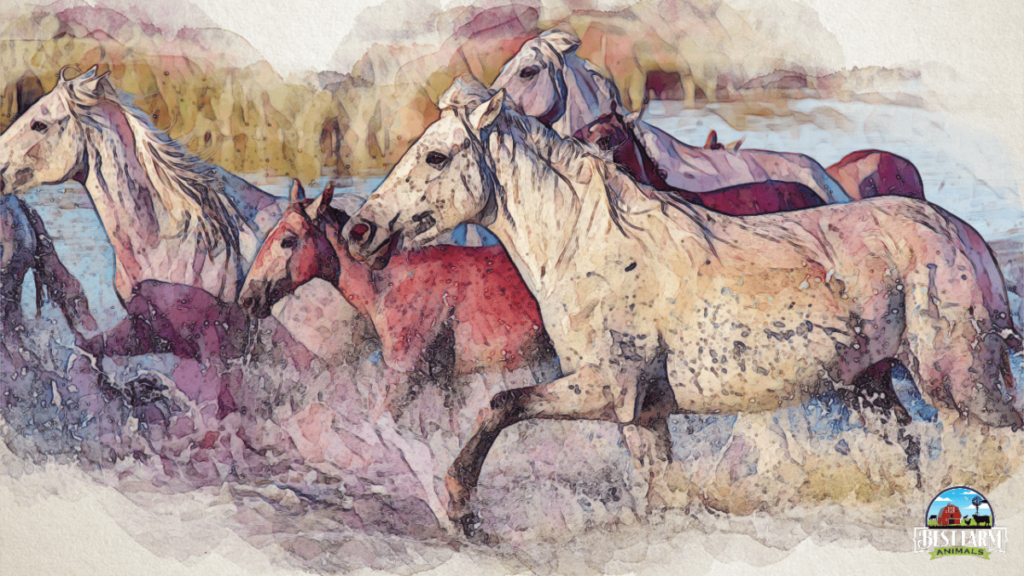
How Far Can You Ride a Horse?
How far you can travel on horseback on a horse depends on the speed of the house. Walking versus galloping will make a difference . While you may assume that galloping horses will travel longer, that is not the case because most horses can travel farther with a ride walking than they can galloping or trotting.
How far you can travel on horseback at a certain speed chart :
These numbers are certainly not the maximum for all horses, but it is the recommended average. Pushing an untrained horse any further or faster than this could result in serious injury. It is possible for a horse to run itself to death.
How long can a horse run? Modern horses can usually run for about 5 minutes, or 2.5 miles before they need to rest. If galloped for the maximum recommended five minutes, a horse should be allowed to rest until it has caught its breath. During recovery, the objective should be between 12 and 16 breaths a minute. Once this rhythm is restored, the horse can be galloped once again.
This can be repeated for up to an hour of galloping time in total per day, meaning around 30 miles could be covered. However, the more frequently the horse is galloped, the longer it will take for it to recover and the slower it will move overall. The hour of galloping may need to be spaced over several hours to allow ample time for the horse to catch its breath in between.
Now that you have a general idea of how fast and how far a horse can travel in any given time, let’s take a look at the different elements involved in regulating these figures.

How Far Can a Horse Travel At a Time?
There are several factors that affect how far a horse can travel at a time. These include age, breed, terrain, diet, and pace. Let’s go more in-depth.
Horse Breeds That Have Higher Endurance
Around 6,000 years ago humans domesticated horses. It was soon discovered they could be used as tools for travel and work, and not long after that did the selective breeding of the ‘strongest’, ‘fastest’, and ‘most beautiful’ horses begin.
For example, Arabians bred and used by cavalrymen and explorers would naturally be better at long-distance traveling than, for instance, a draught horse. It is rational to assume a bigger, heavier horse might have more difficulty traveling long distances than its streamlined, ‘light-footed’ counterpart.
The three strongest horse breeds for endurance are:
- Anglo-Arabian
Age Affects How Far A Horse Can Run
It’s common to hear horses living up to 30 years long. However, at 30 yrs old, no horse could travel more than a couple of miles a day.
A horse’s peak is usually reached between 3.5 – 7.5 years. Within this age period, a healthy horse will have the most stamina and the fastest recovery time in its lifetime. This doesn’t mean an 8-year-old horse cannot travel long distances. It simply means at 8 years or older, the horse will travel slower and need to rest more often.
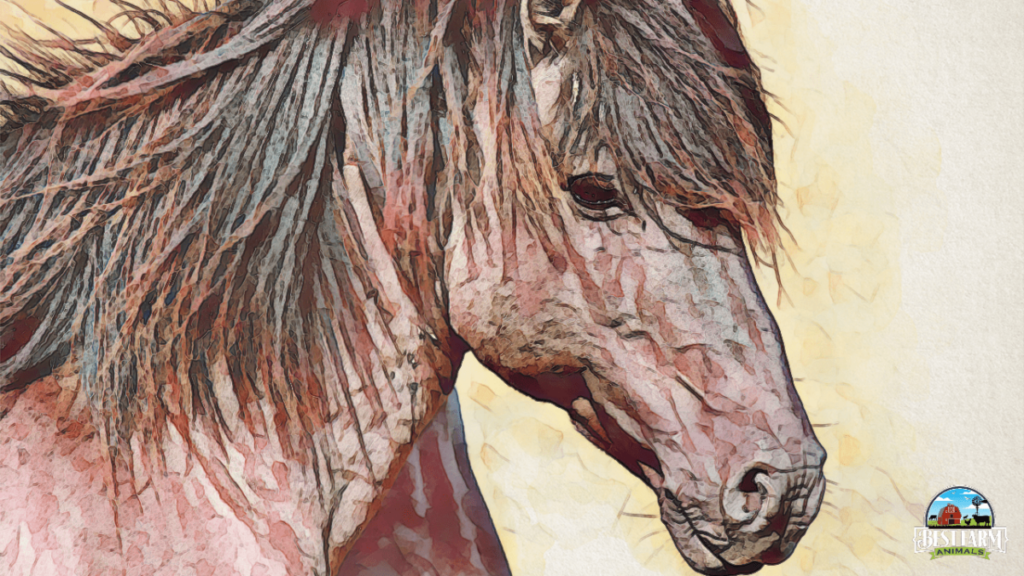
Endurance Training Helps Horses to be Able to Travel Farther At A Time
A horse that’s been conditioned to travel long distances can cover much more ground than an untrained one. Later, we will cover exactly what sort of training and conditioning is used to improve the stamina and speed of any horse.
Weight of the Rider and the Load Impacts Horse Distance
The lighter a rider, the longer a horse can travel without rest. That’s the reason why racing jockeys are smaller riders. It is uncommon to find a heavier jockey. That would put their horse at a distinct disadvantage over horses with lighter riders.
Reducing a horse’s weight will improve the speed and overall distance it can reach. The lighter, the better. A slower horse who that needs to rest more often will cover less distance in any given time.
Terrain Makes a Difference in How Far a Horse Can Travel In A Day
The terrain makes a bigger difference in the distance a horse can cover than most people realize. If the horse is traveling on a stretch of flat, smooth terrain it will move much more easily and faster for longer than if it was moving across a rocky, mountainous region. Sandy ground slows a horse down even more and depletes its energy.
This is why humans take more time to cover the same distance when hiking up a mountain compared to walking across a field.
Diet is Important to Horse Riding Endurance
A malnourished, or underfed horse will become tired quickly.
A healthy diet of alfalfa (which is high in energy), pasture grass, hay, and lucerne mixed with high-fat hard feed benefits a horse’s stamina. It therefore increases the average distance it could travel at any one time.
High-protein feed, on the other hand, would result in your horse needing more water, to urinate more often, and sweat more, all things detrimental to traveling fast and far.
It is also critical that a horse has a sufficient supply of water every day, as well as when traveling, is essential as a dehydrated horse will drop its speed and stamina massively.
Running Pace Determines The Distance
An inexperienced rider might think that a galloping horse will go farther in a day than a horse traveling at a slower pace. But, a gallop actually reduces the total distance a horse can go over a period of time. That’s why most endurance riders will never push their horse faster than a canter for most of a race. A strong horse, with intermediate training can only gallop for around 2.5 miles at a time before needing rest.
Cavalry riders, explorers, and couriers of yesteryear discovered early on that the distance-traveling sweet spot alternated between trotting and walking. This ensures the horse moved forward at a steady pace, while not tiring out so quickly that it would need prolonged periods of standing still to recover. Following a trot-walk pattern, with water breaks in between, a nearly entirely untrained horse could be pushed to reach 35 miles a day.
Tack and Equipment Can Help or Hinder Distance Riding
The tack and equipment used on the horse while traveling can make a huge impact on the distance a horse is able to cover. A wrongly fitted saddle or a too small or large bridle can cause enough discomfort to reduce the distance traveled.
In the same way, the rider’s experience can affect the horse’s performance. In most cases, an inexperienced rider will not reach the same distance or speed as an experienced rider.
Shodding Effects Distance Ability
A shod horse has greater protection for its hooves. In a best-case scenario, this might not directly affect the speed or stamina of the horse. But, it will help prevent injuries or sensitivities that might slow down the horse. More serious injuries can completely stop a horse.
While there are benefits to leaving your horses barefoot, it is not recommended during training or intense exercise.
How Far and How Long Can a Horse Occasionally Ride in a Day?
Untrained, a horse can be pushed to cover a maximum of 50 miles a day, assuming the horse is in good health and age. But, this is not a regular distance and should only be attempted occasionally. This would require stamina on both the horse and the rider’s part. It would also require regular stops for qualitative rest and watering. This distance could take 10-12 hours to complete and would not be viable to attempt regularly.
Trained horses like those competing in the Tevis Cup can easily travel 100 miles in 24 hours. The winners of the Cup usually finish before or around the 12-hour mark. This is, however, only done with regular compulsory stops and vet checks.
Which Breed of Horse has the Greatest Stamina?
Some breeds are naturally better suited to traveling long distances. The top three breeds for horse stamina are Arabians, Akhal-Tekes, and Anglo-Arabians.
Arabians are a lighter breed with long powerful legs which allow them to take bigger strides. They originated in what is now the Middle East, where the Bedouins bred them for use in raids on other camps. They are the most common horse to be entered into endurance competitions, and the horse best suited for long-distance travel overall.
The Akhal-Teke, a horse originating in Turkmenistan, is especially well-known for its ability to weather the extremes. In 1935 a group of riders on Akhal-Tekes rode 2,500 miles from Ashgabat to Moscow in 84 days. This included 3 days crossing 235 miles of desert without water.
Finally, the Anglo-Arabian, a crossbreed between an Arabian and a Thoroughbred, is at the top of the list due to the characteristics inherited from the horses it was bred from. Slightly larger in size, the Anglo-Arabian combines Arabians’ endurance with Thoroughbreds’ speed and agility to create a unique horse perfectly suited for long-distance travel.
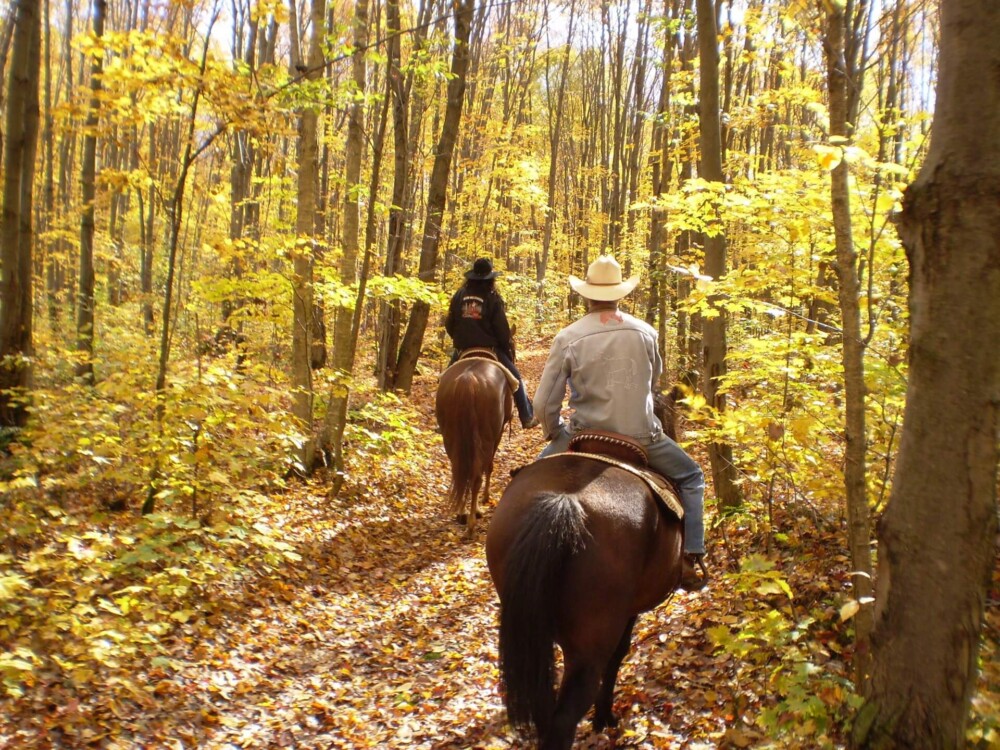
There are other breeds also known for higher stamina than average breeds. They are:
- American Mustang: Mustangs breed in the wild. Due to natural selection, only the strongest horses will reproduce, providing them with naturally high stamina levels.
- Morgan Horse: Bred for stamina. It is known to be able to work all day and still travel at night.
- Rocky Mountain Horse : With a unique 4-beat gait it conserves energy and allows for a smoother ride, both essential to endurance riding.
- Mule: The offspring of a female horse and male donkey , the mule may seem an unusual addition to the list. Due to its breeding, however, it has very impressive muscle endurance allowing it to travel greater distances without tiring.
- Quarter Horse: Their strong-willed temperament means they enjoy a challenge when ridden by an experienced rider. This temperament allows them to travel great distances with the right guidance.
- Hanoverian : Originally used as carriage horses, Hanoverians are muscular, long-limbed horses which make them well suited to traveling long distances.
- American Saddlebred : Initially bred for hunting and cross-country riding, the Saddlebred makes an excellent long-distance traveler.
- Tennessee Walker : As another breed with a 4-beat gait, the energy conservation and comfort while riding makes it an easy choice for riders looking to go the distance.
- Criollo : Native to the Pampas in Latin America, Criollos are tough horses that can be ridden for extensive time periods each day, making them a good choice for traveling far.
Fastest Horse Racing Breeds
If your goal is to cover a great distance in a shorter amount of time, then a fast horse is more important than an endurance horse. Fortunately, many of the endurance breeds are also known for being speedy. You may not be surprised to discover that you can find 80% of all endurance racing horses between these two lists.
Horse breeds known for speed include:
- Thoroughbred
- Standardbred
- American Mustang
How to Train Horses to Travel Greater Distances
Without the right training, not even the fastest breed with the highest stamina level can complete strenuous distances. A trained horse, not bred for its stamina, could easily outlast a perfectly bred endurance horse without training .
Training and conditioning make all the difference in performance.
When training a horse for distance, it is imperative to train gradually. On average, it can take up to a year of training to get your horse to the point where it can comfortably complete 60 or more miles at a time.
Let’s discuss the best methods to increase your horse’s stamina, and condition it for covering longer distances of travel. It is also important to note that all training times below are listed for shod horses. If your horse is barefoot , training time must be doubled. The best shoe type for horses traveling long distances is flat steel shoes.
Distance Training Phase I: Beginner Level
Duration; 6-8 weeks
This period is used to prepare your horse for continuously increasing exercise times and intensity and to condition its hooves and muscle to the work it will do.
- Between 4 and 5 days a week, walk your horse at an active pace. This should not be done on the same terrain every day. It is recommended that you train on as many different landscapes as possible. This can include fields, gravel, mountains, and even sand. Training times should be up to about 3 hours per day at the end of the 6 or 8 weeks.
- Once a week, the horse should be trotted in a lunge. This should not exceed half an hour without rest, and should never exceed 90 minutes overall. The horse must learn to maintain the correct form while trotting (head low, back rounded, and neck extended), and do so in a relaxed manner, so as to perfect its stride.
- Near the end of the beginner period, trotting should be added to the walking training. This should be done at the same pace as with the lunge, and for no more than 20 minutes per session.
- One day a week must be given for the horse to rest. At the beginning of the training period, recovery is essential, and this is impossible without allowing the horse a full day off.
Distance Training Phase II: Intermediate Level Duration; 6 weeks
- Five days per week, follow this pattern; warm-up for 15-20 minutes at a quick walk, then proceed to use the trot-walk formation for increasing amounts of time. By the end of this level, the horse should be able to trot for 2 hours uninterrupted.
- Two days a week should be allowed for rest and recovery. Allow no more than light outrides, or very light lunging.
Distance Training Phase III: Advanced Level Duration; 2-3 weeks
At this level, a comfortable canter should be achieved. Focus on the horse’s fitness levels while ensuring the rider and animal enjoy the exercise.
- 3-4 days per week of training should consist of a 15-minute warm-up, and then alternating between a canter, trot, and walk. By the last week of training, the horse should be able to maintain a canter-trot formation for a total of 90-100 minutes.
- Allow 3-4 rest days now that the training is more intense.
Following the above program will show obvious changes in your horse’s stamina and physique. It will also cover longer distances with much greater ease when kept in trot-walk formation with occasional cantering.
The program above covers the first 3 months of training. Once this intermediate level of stamina has been reached, the intensity of Phase III training sessions should be gradually increased. This training regimen should be interspersed with days in a lunging arena or riding school. The foundation built in the first three months of training will serve as the point for further developing your horse’s abilities.
To reduce the chances of injury or illness during training, it is important to take a holistic approach to the program and listen to your horse. If they start a training session on low energy, it is better to add an extra rest day instead of pushing them to complete the workout.
If a sensible, dedicated approach is taken, the difference in the way your horse performs may astound you.
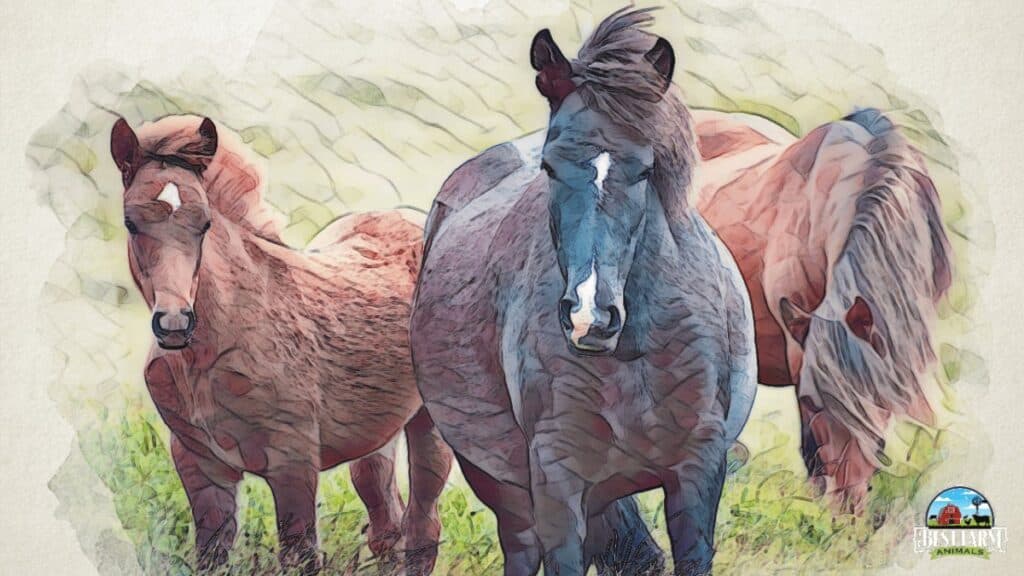
Horse Travel FAQs
How far can a horse run without stopping? Horses can run 2.5 miles without stopping unless they have been conditioned to run farther. The average horse is stabled or kept on a pasture and doesn’t spend large portions of its time running or galloping and isn’t as in shape as horses were five decades ago when they were used for travel more often.
How far can a horse travel in 3 hours? A horse can walk 4 miles an hour and trot eight to twelve miles an hour. If a horse is conditioned and fit, it can usually cantor between 12-15 miles an hour and gallop 25-30 miles an hour. But, most pet horses are not conditioned enough to sustain a gallop or cantor non-stop for an hour and will need to rest after a few miles.
How Many Kilometers Can a Horse Run In A Day? A horse can run about 40 to 55 kilometers in a day, depending on how well conditioned it is. A well-conditioned horse can run up to 80 km a day with some horses able to run even farther. But, you should not attempt to run an average horse that far because it can cause injury and harm the horse.
My Favorite Equine Resources For Horses and Donkeys
This list contains affiliate products. Affiliate products do not cost more but helps to support BestFarmAnimals and our goal to provide farm animal owners with accurate and helpful information.
Squeaky Chicken Toy is hilarious to watch and the horses love it! It’s not super tough so keep it away from dogs.
Dewormer with Ivermectin : I use this for my horses and my goats. Duvet makes a great dewormer. I switch between the Ivermectin one and one like this one so the worms don’t get immune to it.
Manna Pro Apple Flavored Nuggets are a delicious smelling treat that my horses go crazy over.
Equinity Amino Acid Supplement for Horses makes a big difference for any horse that’s struggling with arthritis, hoof issues, or just generally. It’s great for older horses who can’t absorb all the nutrients in their food as well!
Manna Pro Weight Accelerator helps older horses gain weight and stay healthier! This was especially helpful when one of my older horses lost weight over the winter and helped her regain her weight over the summer!
Farnam Fly Control goes on the horse or donkey and will keep the flies off your sweet pet. It makes horses way more comfortable and will keep sores from getting infected as well.
Wound Kote protects sores and wounds. It acts as an antiseptic and helps wounds heal faster. It works on both my horses and goats.
Ever since ancient times, horses have been used as a means of transport and work by people of all classes, from peasants to kings. They can reach extraordinary levels of endurance with the correct training and riding.
From the days of the Pony Express, and the years of war where cavalrymen and steeds were used, until today where most endurance horses are prized mainly for their racing abilities, horses’ stamina and speed have been of utmost importance whether as a matter of pride, or the difference between life and death.
Wikipedia: Akhal Tekkes

Welcome to Savvy Horsewoman
Posts may contain affiliate links and/or sponsored products. See the Disclosure.
How Far Can a Horse Travel in a Day
Wild horses now vs. in the past.
Horses are used much differently today than what they were used for in the past, regardless of if they are domesticated or wild. Because of today’s changes in technology and transportation, horses are no longer needed to pull wagons or ride like they were during pioneering journeys. The distance a horse is able to travel is largely dependent on its endurance , and since they are not used as frequently for endurance-heavy activities nowadays as they once were, their ability to travel greater distances has been impacted. Horses in the past used to frequently travel up to 35 miles per day, but now they are rarely able to go more than 25 miles in one day. It is important to note, however, that a horse kept in good shape can travel up to 50 miles in a day.

How Horses Are Built
As a flight animal, a horse will gallop or canter away for a short distance from danger. When they need to get out of immediate danger, horses will trot longer distances. The average horse cannot gallop for more than a couple miles before getting tired. This is why they may gallop to get away from immediate danger, but will switch to a slower gait (such as a trot or canter) when traveling longer distances. Historically, the Pony Express horses were only able to travel about 10-15 miles at a canter or trot before a rider would stop to switch to a “fresh” horse.
How Far Can A Horse Travel In A Day
There are many factors that go into how far a horse can travel in a single day. Some of the main factors are how fit your horse is, their skills, and how well you take care of your horse. Other factors are what equipment is used on the horse and the severity of the weather and terrain. Having proper rest, plenty of clean water, and being well-fed is going to greatly help the distance in which your horse can travel in a day.
How Far Can a Horse Travel at Each Gait?
How many miles per day a horse can travel depends on the gait at which it is traveling, as well as the terrain that they are covering the distance over. At a steady walking pace, a horse can travel 25 to 35 miles per day. When traveling at a trot, a horse can go about twenty miles. A cantering horse moves at about 10-17 miles per hour, which means a very fit horse can travel about seven miles; however, the more average horse will not be able to travel nearly as far. Finally, when galloping, the average horse cannot travel more than two miles before becoming fatigued.
How Fast Can a Horse Travel at Each Gait ?
There are four gaits at which a horse can travel. A walking horse is moving about 4 miles per hour. When urged to a trot, a horse’s speed goes up to about 8 to 12 miles per hour. The next gait is a canter, where horses are clocked at going anywhere from 10 to 17 miles per hour. The fastest gait, called a gallop, is where a horse travels 25 to 30 miles per hour.
How a Horse’s Health and Fitness Impacts Distance
A horse’s overall health and fitness impacts just how much distance in a given day it can cover without an issue. Typically, your more endurance-trained horses can cover up to 100 miles per day. An average trail horse can cover upwards of 50 miles within a day. Mostly, either type of horse can not go more than a few consecutive days at this distance without a few days of rest and recovery in between.
How Weather and Terrain Impact Distance
Depending on the terrain and weather, horses will not cover the same distance over tougher terrain than smooth terrain. Unknown terrains, like rocky areas and hills and mountains, will naturally slow a horse down as they carefully navigate through them. These tough terrains also put more strain on a horse’s cardiovascular system.
Going over various types of terrain will also put different types of loads on the horse’s joints and hooves. Avoid injuries by taking things slow, which will increase the overall travel time. Hoof protection is an option for those wanting to give their horse’s a bit of a barrier between their hooves and the terrain in which they will be covering.
When the weather is a concerning factor, make sure to keep an eye on it where you are and where you will be traveling. Do not go out in extreme hot or extreme cold weather. Most horses are able to travel the best at the optimal temperatures of 70 to 90 degrees Farenheit (21 to 32 degrees Celsius). With rain, no horse or rider particularly wants to be out riding, especially since rain can cause the ground to become muddy and make it difficult for the horse to safely move. After a few short miles, try to find shelter to wait out the storm.
Extreme weather can cause injury and illness in horses. In too hot of weather, horses can lose electrolytes through sweat, even if there is low humidity that causes the sweat to quickly evaporate. On the other side of the spectrum, too cold weather can cause muscles to freeze or tense up, and the hard ground can negatively impact a horse’s hooves and joints.

Feed, Water, And Rest The Horse
Sufficient rest, water, and food will allow a horse to recover from a trip faster. Allowing your horse to rest and have access to clean water throughout the trail will ensure a better journey overall, as this will help it be able to safely travel longer distances. It is a good idea to check ahead of time and make sure there is plenty of water along the route which you plan to ride your horse when traveling longer distances.
Tack & Equipment
As with any riding, proper fitting tack is essential. Equipment that is ill-fitting can and will influence the distance of travel you do in a day. One precautionary step that you can also take is making sure that your horse’s shoes are not at the end of a cycle, as well as that the nails are not loose. Keeping a hoof boot or two in a saddle bag in case of emergency will be a savior in case a shoe comes off mid-journey.
Rider’s Skills And Fitness
As a rider, do not overdo a journey or long trip that is out of your capability. To check your own personal stamina over distance, take multiple shorter-mile trips prior to the long trip. If your riding skills are not able to maneuver through tough terrains, such as rocky areas, puddles, and rivers, it would be best to plan a different route. You do not want to end up stuck in the middle of nowhere!
How to Condition Your Horse for Long-Distance Travel
Conditioning your horse for long-distance travel is similar to that of a marathon runner. You wouldn’t take your horse out and ride as far and long as possible on the first day. Building up both fitness and stamina by starting out with shorter, small day-trail outings is essential to keeping your horse healthy while preparing it to travel long distances. As you and the horse get fitter and are able to more easily travel the shorter, smaller distances, you can gradually increase the mileage.
Gradually increasing travel distances is not the only way to condition your horse for long journies. Riding over various terrains will also help both you and your horse learn how to navigate a long ride. Not only does it allow the horse to adjust to carrying its weight differently over the various terrains, but you will also become aware of how the horse feels when it adjusts itself.

How fast can a horse run?
A horse can run 25 to 30 miles per hour at a gallop.
What is the fastest a horse traveled 100 miles?
The fastest 100-mile record is an endurance horse that covered the distance in 5 hours, 45 minutes, and 44 seconds.
How many miles can a horse travel in an hour?
How many miles a horse can travel in an hour is dependent on its gait.
How far can a mule travel in a day?
Mules can travel up to 20 miles a day. They typically have more stamina than a horse, and also tend to be steadier over rougher terrain due to the fact that they can see where they put their hind feet , which a horse cannot do.
How far can a horse gallop?
On average, a horse can not travel more than 2 miles at a gallop before becoming fatigued.
How far can a horse trot?
A horse can continuously trot 20 miles.
How long would it take a horse to travel 100 miles?
Unless you are on a fit endurance equine athlete, most trail horses in good shape can cover 50 miles in a day.
How far can a horse travel in 5 days?
If on average a horse can travel 25 – 50 miles a day, in five days a horse can travel 125 – 250 miles.
How far can a horse travel in 8 hours?
At a comfortable walking pace, a horse can travel 32 miles in 8 hours.
You may also enjoy:
5 diy ideas for displaying horse show ribbons, horseback riding while pregnant 10 practical tips, becoming a stable mom – riding post-pregnancy, all you need to know about horse …, leave a comment cancel reply.
This site uses Akismet to reduce spam. Learn how your comment data is processed .

- Other Animals
What Is the Average Distance a Horse Can Travel in a Day?
If you're getting your gear together and packing up your trailer for a fun trail-riding adventure with your trusty steed, you may be wondering how much ground is safe to cover on each day of your adventure. You will need to consider several factors when making your riding plans -- terrain, overall fitness of all the horses in the group, weather conditions and pacing are all important factors.
Picking the Pace
The total distance covered by a horse in a day will be determined largely by the pace that you set for the ride. A horse's speed depends on gait:
Walk: 4 mph Trot 8 to 12 mph Canter 12 to 15 mph Gallop 25 to 30 mph
A typical horse may be comfortable walking for eight hours, meaning he could cover 32 miles in that time. Many weekend-warrior riders can't stand eight hours in the saddle, though. A more fit horse may cover more distance if he is able to trot or canter for part of the time.
Terrain and Footing
It is important to consider the terrain your horse will be navigating when determining how far to ride each day. Navigating up or down steep hills is more taxing on your horse's limbs and cardiovascular system than travel on even ground. If the terrain is hard or rocky, the concussion on your horse's hooves and joints will be more pronounced, so you will want to reduce the distance you travel on that terrain and slow your pace. Very deep mud or sand is more stressful on the tendons and ligaments of your horse's legs than firm footing, so take care under those conditions.
Weather Conditions
Consider weather conditions when planning your ride. Horses lose a tremendous amount of body water and electrolytes through their sweat. If a horse becomes dehydrated or electrolyte-depleted during a ride, he can suffer severe health consequences. In very hot and humid weather, plan to make frequent stops. Administer electrolytes during long rides when your horse is actively sweating. In hot, windy weather with low humidity, sweat evaporates quickly -- so the horse will appear dry even though he is losing electrolytes and water through his sweat. Horses should always be willing to eat and drink throughout a ride. If your horse is unwilling to eat when you stop to offer a bite of grass, he may be getting exhausted and may need to stop for the day.
Overall Health and Fitness
All the riders in a group should plan their pace and distance based on the least fit horse in the group. Older horses may have a touch of arthritis in their joints. They might be willing to keep up with their younger trail partners but may become lame following an intense ride. Horses are strongly in tune with other members of their groups and will push themselves beyond what is safe in an effort to stay with the group. It is the rider's responsibility to prevent a horse from overexerting himself. If your horse is not in a regular training program to build up his cardiovascular fitness, do not let him overdo it on a long trail-riding adventure. Tired horses are more likely to stumble and injure themselves. Keep the pace slow and relaxed, and enjoy the company of your fellow riders and the beautiful scenery.
- Equestrian and Horse: Horse Gaits
- American Endurance Ride Conference: Assessing FItness
- DVM360.com: Sweating the Small Stuff
Photo Credits
Thomas Northcut/Photodisc/Getty Images
See More Animals

- Skip to primary navigation
- Skip to main content
- Skip to primary sidebar

- Heartwarming
- Tips For Riders
How Far Can A Horse Travel In A Day?
Modified: Sep 5, 2020 by Wendy Sumner · This post may contain affiliate links ·
I'm sure you've heard the saying, “It is a day’s ride away.” But what exactly does that mean? How far can a horse travel in a day? The truth is, no one answer is correct. In this article, we learn about several factors that can affect the answer to how far a horse can travel in a day.
Horse Ownership has Changed in the Last 100 Years
We rely on the fitness of our cars to get us around today. Therefore, we schedule regular maintenance like oil changes, fluid checks, and tire rotation, etc. Just over one hundred years ago, horses were the primary source of transportation. A horse was considered a tool that needed the best care, maintenance, and fitness. Every farmer understood the necessity of good equine health and conditioning, just like today’s mechanics understand the requirements for keeping vehicles running correctly. Consequently, the average horse in the past was conditioned to travel farther than today’s average horse.
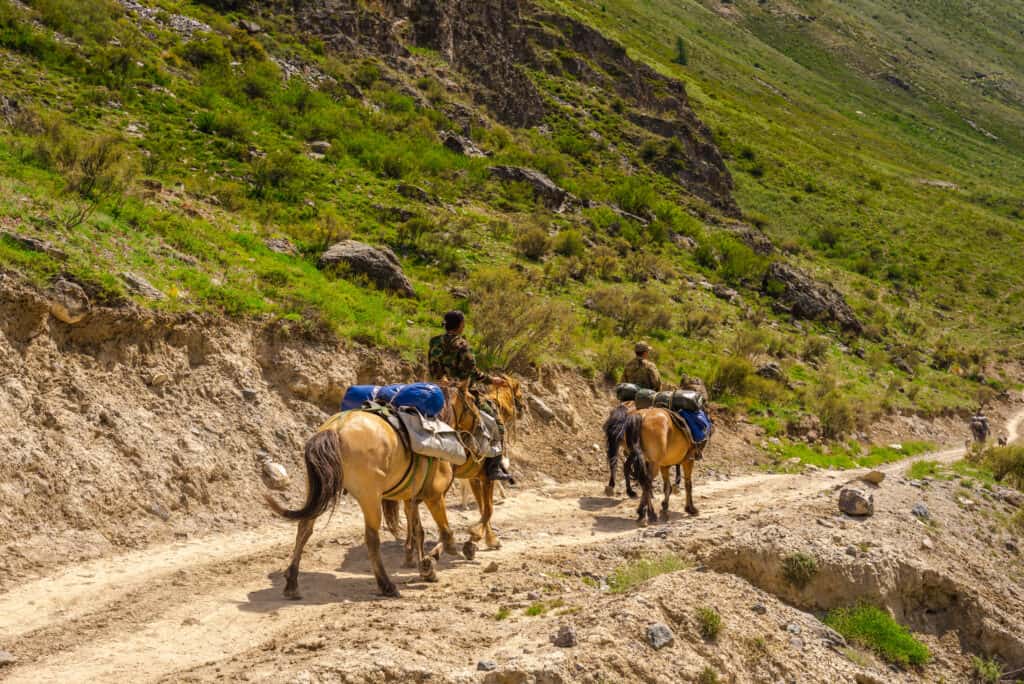
One Day Trip vs. Consecutive Days Trip
Years ago, as well as today, riders needed to take into consideration how many days the trip would take. On average, a healthy horse can travel anywhere from 25 to 35 miles a day. This distance needs to be at a slower pace and with breaks for water. However, asking a horse to keep up this pace for several consecutive days can lead to health problems.
Breeding vs. Backyard Horse vs. Seasoned Equine Athlete
The majority of horses fall into one of these three categories.
- “breeder’s herd.”
These are the horses that are in selective breeding programs to facilitate desired breed characteristics. These horses travel only short distances, usually within their pastures. The tolls of raising foals year after year can have an adverse effect on how far a broad mare can travel. It would take some conditioning to build up to 25 miles in a day.
- The backyard horse.
These horses are the ones that fall into the position of a family member or pet. When asked about how horse ownership has changed in the last 100 years Robert Hilsenroth, DVM, executive director of Morris Animal Foundation , had this to say, “Horses were coming away from the farms, being boarded, and becoming pets. Their value changed from one of horsepower to one of love or companion power.”
Backyard horses that are sound and healthy can usually make 25 or even 35 miles a day. Fifty miles a day is achievable with some physical conditioning. Before taking a backyard horse on a 35+ miles ride, it is of utmost importance that the rider considers the physical condition of the horse.
- The seasoned athlete.
These horses are conditioned and trained to be at the top of their respective disciplines. It doesn’t matter if it is upper-level dressage, three day-eventing, reigning, working cow horse, barrel racing, or other events. These equine athletes receive all the care and treatment you would expect any human athlete would get.
The seasoned equine athletes conditioned for endurance racing are prime examples of how far a horse can travel in one day. Endurance races can be anywhere from 50 miles to 100 miles. The fastest 100 miles race was set by Yousuf Ahmad Al Beloushi on an eleven-year-old gelding. They averaged 17 miles per hour and finished in 5:45:44 seconds.
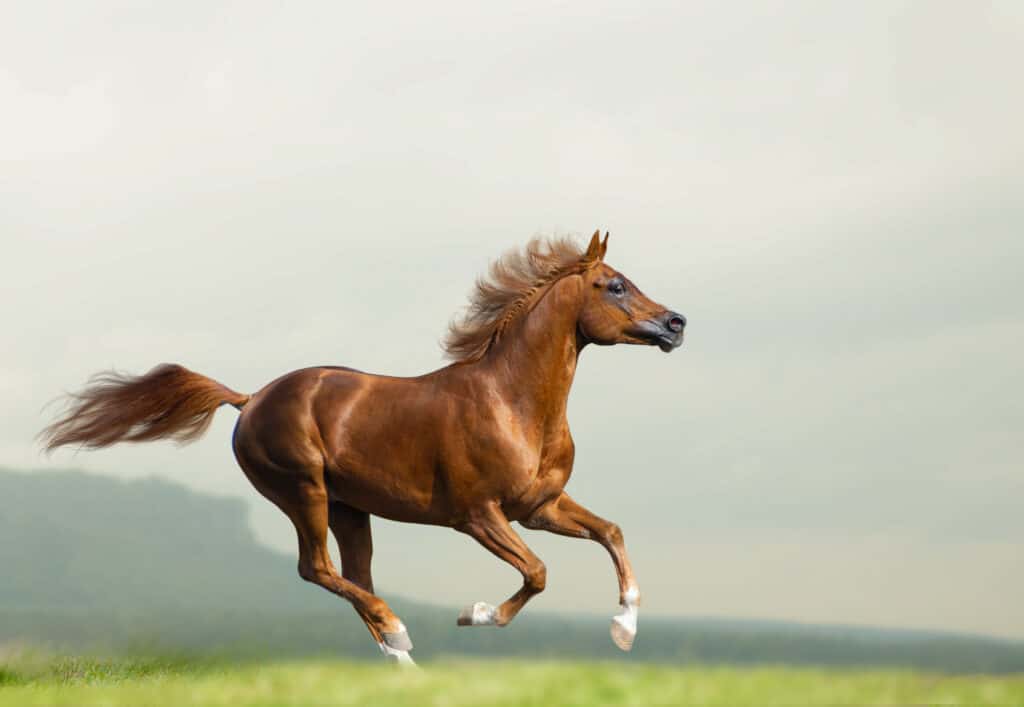
Conditioning for a Riding Discipline
When we ask if an equine athlete is capable of traveling 50+ miles a day, we need to keep in mind the horse’s discipline. Is the horse required to have a short burst of high speeds, like a racehorse? Does the horse need to move in collected meticulous strides like a dressage horse? Are they leaping over cross-country jumps while making the fastest time? Do they make quick side to side moves like a cutting horse? The list can go on!
Conditioning for a healthy horse is very similar for each discipline. Proper nutrition is at the top of the list, followed by regular training and a body conditioning regiment.
At the same time, each discipline also has distinct needs for that particular discipline. Endurance conditioning takes a lot of time and special care to keep the horse healthy during a 50+ miles race.
Traveling on Different Terrain
The terrain that is traveled on can make a big difference. Traveling across flat, open ground will be easier and faster than navigating hilly or mountainous terrain.
Proper Equipment for the Horse
The proper fit of the equipment used can have a significant influence on how far a horse and rider can travel in a day. An ill-fitting saddle can cause serious deep muscle issues along with painful skin rubs. A bridle that is too tight or has a harsh bit can also create problems.
Horses need to have the proper shoes for the terrain. Losing a shoe in the middle of an all-day ride can be an excellent way to cut it short. This is especially true if the terrain is rocky or the horse tends to be tender footed.
Equipment that is well maintained is also necessary. If a billet strap (English) or a latigo strap (Western) breaks, it could be a long walk home.
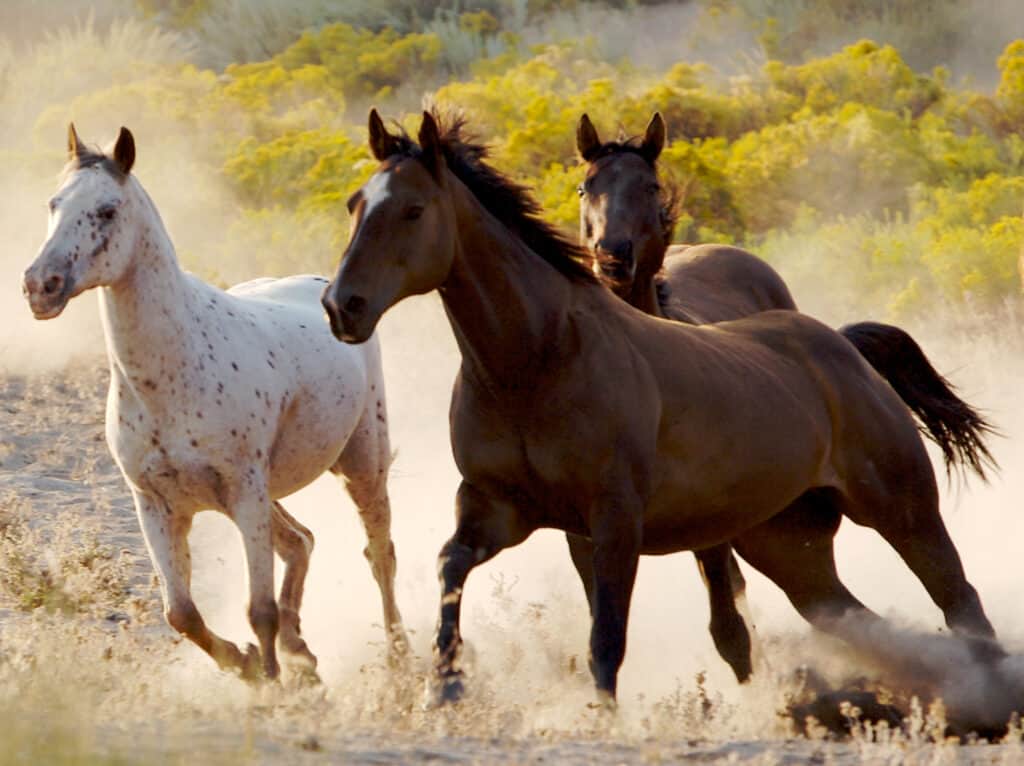
Final Thoughts:
Many factors can affect how far a horse can travel in a day. The distance traveled by the average horse 100 years ago has changed compared to the average horse of today. The most important consideration is the horse’s physical health and conditioning.
Horse Courses by Elaine Heney
- Listening to the Horse - The Documentary by Elaine Heney & Grey Pony Films
- Shoulder In & Out Training for better balance, bend & topline development with your horse
- Over 110+ Polework Exercises & Challenges to Download
- Dancing at Liberty & Creating Connection with Your Horse (11 lessons) - Grey Pony Films
On average, a healthy horse can travel around 25 to 35 miles a day. A horse that is trained to be a top athlete has the possibility of traveling even further. It depends on what discipline they are trained in. Endurance horses are trained specifically to cover distances up to 100 miles in a day.
Did you learn anything new and interesting about our equine friends? Share this article with other horse lovers that you know so that they can learn something, too.
Have you ever wondered how much the average horse weights? Find out the answer here on iHeartHorses.com.
More Fun Facts

Sharing is caring!
Terms and Conditions - Privacy Policy

How Fast & Far Can a Horse-Drawn Carriage Travel?
By: Author Anna Stanek
Posted on Last updated: 09/19/2021
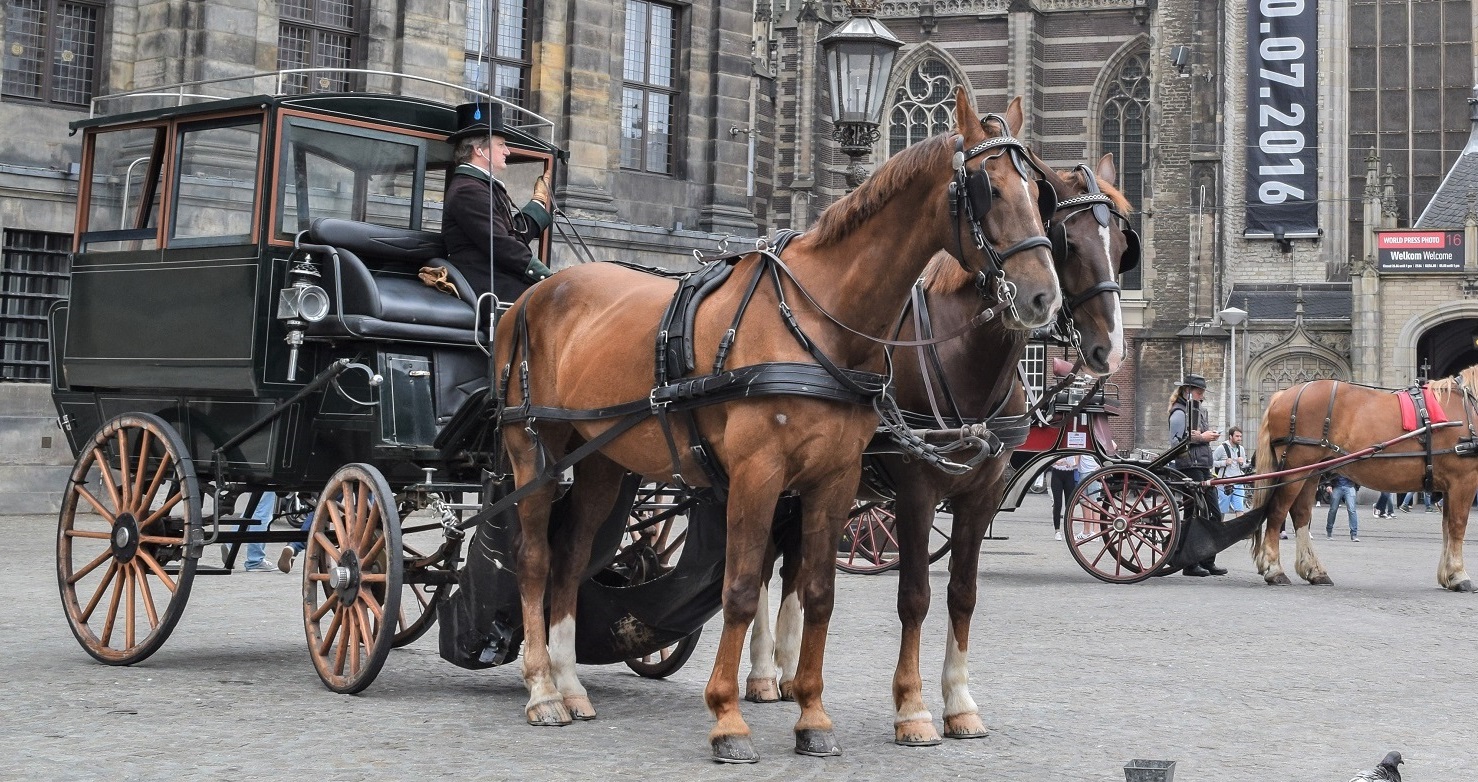
This post may contain affiliate links. We earn from qualifying purchases. Learn More
For thousands of years, horses have been used for transportation. Horse-drawn carriages have allowed for travel that otherwise would have been very difficult or even impossible for people.
Though cars have taken over as the main source of transportation, horse-drawn wagons are still used in some parts of the world for transportation and work. In addition, horse-drawn carriages are popular today for leisure and competition.
How Fast Does a Horse-Drawn Carriage Go?
At a trot, a horse-drawn carriage will go around 8-10 MPH. At a walk, a horse-drawn carriage will go about 2-4 MPH. The speed of a carriage depends on the weather, terrain, horse, and other tractors.
Generally, horses do not canter or gallop with a carriage. Though in movies you will often see horses galloping with wagons, it is not common in real life. Cantering or galloping with a carriage or wagon can be dangerous and it is also a lot more work for a horse.
In some cases, however, rodeos will host chuckwagon races. In chuckwagon races, a hitch of two to four horses race on a track, normally for half a mile. However, the sport has faced controversy as it is dangerous and has led to the death of several horses over the years.
When at the canter, a horse-drawn carriage goes approximately 10-15 MPH. At the gallop, the speed will be around 18-25 MPH.
How Far Can a Horse-Drawn Wagon Travel in a Day?
On average, a horse-drawn carriage can travel between 10-30 miles a day. The distance will depend on factors such as terrain, weather, horse, and weight of the carriage.
In hot weather, a horse’s workload should be reduced in order to prevent overheating. When the humidity and temperature add up to 150-160, a horse should only do light work. This means they should generally only travel ten miles or less in a day. When the humidity and temperature add up to 160 or over, a horse should not work.
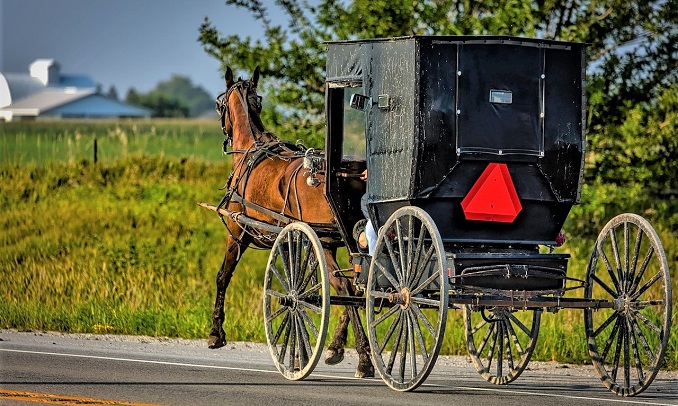
If a horse is traveling across hilly, uneven terrain, it will be more challenging for them to pull a wagon. Though on flat terrain they will be able to up to 30 miles or even more, they won’t be able to travel that far in a day over rough terrain.
Weight is another aspect that will affect how far a horse can travel in a day. Though horses are capable of pulling thousands of pounds over short distances, they won’t be able to pull that much weight across several miles. Horses will have no problem pulling a few hundred pounds to even a couple of thousand pounds, depending on their size. However, any more than that will be difficult over longer distances.
How Much Weight Can a Horse Pull?
A horse on average can pull 1.5 times its body weight over a long distance with a carriage. When traveling a shorter distance, they are capable of pulling three times their body weight.
On average, a 1,000-pound horse can pull 1,500 pounds across long distances. Across shorter distances, a 1,000-pound horse has the ability to pull up to 3,000 pounds.
Horses are also able to pull more together than they can apart. Two horses are capable of pulling up to three times the amount of weight they could by themselves. So, a draft horse that could pull 6,000 pounds by itself would be able to pull up 18,000 pounds with another horse across a short distance.
In pulling competitions, draft horses have been known to pull 10 to 15 times their body weight. Though they wouldn’t be able to keep this up over long distances, it is still very impressive.
In 1924, a pair of Shire horses set a world record by pulling a whopping 100,000 pounds. That same year, a single Shire defied the odds and pulled 58,000. Talk about some truly astounding horsepower!
More recently in 2012, a team of Belgian draft horses broke the record at the world-famous Calgary Stampede’s Heavy Horse Pull by pulling a deadweight of 13,400 pounds. Then, in 2014, another pair of Belgians at the National Western Stock Show wowed the audience by pulling a staggering 17,000 pounds.

What Breeds of Horses are Used for Carriage Driving?
Draft horses are popular choices for carriage driving. Their sturdy builds allow them to pull heavy loads. In addition, their calm dispositions make them reliable horses. Draft breeds such as Belgians, Percherons, Clydesdales and Shires are all great breeds for driving.
In addition, there are many other horse and pony breeds that excel at driving. These breeds include the Friesian, Morgan, Hackney, Dutch Harness Horse, Gypsy Vanner, Welsh, Haflinger, Cleveland Bay and Saddlebred. However, with the right training, just about any breed can excel in driving.
Types of Carriages, Wagons and Carts
There are many types of horse-drawn carriages, wagons and carts that can have two or four wheels. The most common ones are Barouche, Hackney Coach, Stagecoach, Meadowbrook, Pleasure Cart, Fine Harness Buggy, Landau, and Prairie Schooner.
A Barouche is a four-wheeled open carriage that is often pulled by one or two horses. It has a heavy, luxurious build that holds at least four people and often features a collapsible half-hood. The style is common among carriage ride companies today.
Hackney Coach
Hackney coaches are one of the first types of horse-drawn carriages that traditionally people would keep for hire. They are an enclosed four-wheeled carriage that includes seating for four to six people with a simple design. They often have a hitch of two or four horses.
Stagecoaches are most recognizable from old western movies and TV shows. Originally for public transportation, these large, heavy carriages have four wheels. They often consist of a two, four or six-horse hitch.
Meadowbrook
A Meadowbrook cart is a two-wheeled open carriage, that features large wheels. They include two seats, where one seat folds for rear entry and is pulled by one horse. Today, they are commonly used for carriage driving competitions and pleasure driving.
Pleasure Cart
Pleasure carts are two-wheeled vehicles that are pulled by a single horse. They have a simple design and can seat two people. They are a popular choice for horse shows.
Fine Harness Buggy
A fine harness buggy is a four-wheeled vehicle that sits one person. They have a simple yet elegant design. They are used especially for horse shows.
A Landau is a four-wheeled carriage that has a collapsible, full-coverage roof. They are often luxurious in style and have long been a popular choice among royalty. They generally have seating for four to six people and have a two or four-horse hitch.
Prairie Schooner
Prairie Schooners, also known simply as covered wagons, were pioneers’ main form of transportation while traveling across the American West. They have four wheels and a cotton canvas cover. Covered wagons are spacious, with room to hold several people and large amounts of supplies.

How Far Could A Horse Travel In A Day? – The Best 5 Horse Travel Tips
Last Updated on April 26, 2022 by Fabiola L.
When you’re trying to find out how far a horse could travel in a day, you need to know the answers to these three questions before you can start measuring distances. How old is your horse, how well-fed is your horse, and in what environment you are testing the performance and distance of your horse.
Have you ever wondered the exact distance of a day travel by horse? You might have guessed “as far as it needed to,” but have you ever stopped to think that a horse’s gait depends on its speed, and that its speed depends on how much weight it is carrying?
While a horse can run at full gallop for miles at a time, there’s a reason why our ancestors domesticated them—and it’s not just for their companionship. In fact, horses were used as pack animals in the ancient world and are still used for transporting people and goods today.
So, to answer the question on how far a horse could travel in a day, we must take in mind many factors which would affect the performance of your horse. To get the answer to this question, read further about our horse travel tips and performance. In addition, we are going to cover the average distance a horse could travel in different conditions.
Table of Contents
What Breed Of Horse Is Best For Travel – How Far Could a Horse Travel in a Day
A horse is a great way to travel, but not all horses are good for travel. There are many different breeds of horses, and each breed is useful in different situations. For example, a pony is great for people who want to ride and have limited experience, because it takes a smaller amount of training.
However, ponies tend to be slower than the larger breeds, and are less stable. On the other hand, a draft horse can be just as efficient, but is more stable and better suited to carrying a rider for long distances.
If you’re looking for the best breed of horse to travel with on your next road trip, it’s a good idea to get a feel for what kind of riding experience you’re most comfortable with.
Most people are pretty comfortable riding a horse on a trail or on a paved road. Some are more comfortable with a western-style horse, and others prefer to ride a horse over a horse-drawn carriage. And if you’re new to the sport, you might want to try riding a horse in a dressage-style competition first. The key is to find a horse best suited to your riding style and comfort level.
How Far Could A Horse Travel In A Day – Scientific Approach
There are different ways to explain the horse travel experiment, but I find the one used in this example (as well as other explanations I’ve seen) to be the easiest to understand. The original experiment was done in the late 1800s, in which scientists decided to test how far a horse could travel in a single day.
At the time, horses were considered a major transportation system in Europe. In order to see how fast horses could travel on a given day, the scientists set out to determine the fastest possible speed, which was limited by their ability to stay hydrated .
In order to ensure that the animals stayed hydrated, the scientists put them on a schedule in which they drank from water fountains every three hours. It took researchers almost 20 years to get their results, but when they did, they found that the average horse could travel a distance of about 50 miles per day.
Find more information about How Many Miles Can A Horse Travel In One Day?
What Are The Best Conditions For Horse Traveling
To begin with, the horse should be sound and in good shape for travel. He should also have been trained to be a traveler. The horse should be properly saddled. Make sure he has food and water before the trip and take care of any health problems before he leaves. Horses need to be fed well, and they shouldn’t be packed tightly or restrained.
Learn more about What Are Summer Sores In Horses?
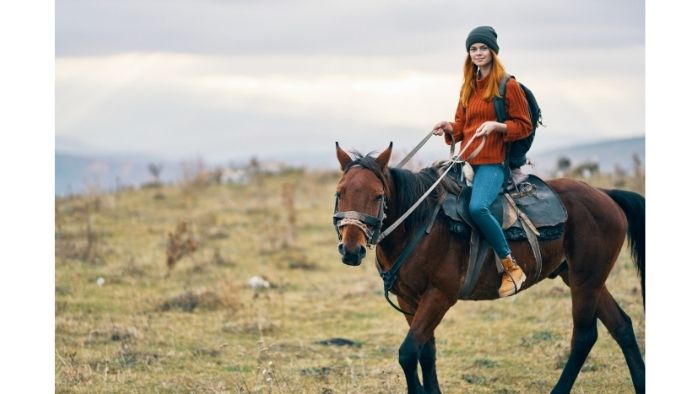
How To Make Your Horse Faster
To increase the speed of your horse, you have to start working on the strength of its muscles. If you can make the muscles stronger, they’ll be able to handle the demands of your horse.
You may not think that you can improve the speed at which your horse is galloping, but by changing just a few things, you’ll see an improvement in your horse’s ability to perform at its best. Here are some of the ways to make a faster horse:
• Make sure your horse is properly fit. If it isn’t, the horse will be running in a gait that isn’t natural.
• Give your horse proper nutrition. When it’s hungry, it will run more efficiently.
• Give your horse enough rest. It’s important for your horse to have time to relax and rest between workouts.
• If you’re going to ride your horse in a race, make sure you know how to set the pace.
• Finally, when your horse is racing, give it positive feedback. Positive reinforcement works better than negative reinforcement.
How Much Weight Can A Horse Carry
When it comes to how much weight a horse can carry, there are some things that determine its maximum carrying capacity. Horses are built to carry weight, which is the weight a horse is designed to handle.
The amount of weight a horse can handle depends on its body structure. The horse’s frame is its backbone, neck, and legs. The strength of the horse’s muscles determines how much weight it can handle.
What Are The Best Foods For Horse – Horse Nutrition
A horse nutritionist can offer you a plethora of advice, but they are really there to help you figure out what will work best for your individual needs. Your veterinarian can also offer you some useful tips, as can any of your fellow horse owners. The first step is to determine your horse’s nutritional needs.
The most important aspects of feeding a horse are to ensure that the horse is getting enough energy and vitamins. A lot of horse nutrition books and websites out there will recommend feeding hay and grain. If you have experience with horses, you know that feeding only grain does not allow for your horse to have an ideal diet.
To achieve optimum performance, your horse needs to be fed a well-balanced, high-quality diet with the proper amount of protein, carbohydrates, fat, fiber, minerals, vitamins, and amino acids.
Conclusion On How Far Could a Horse Travel in a Day
In conclusion, The Top 5 Horse Travel Tips are: Always travel with a water bottle. It’s important to keep hydrated, especially if you are riding for a long period of time.
You should always check your horse’s mouth and teeth for potential problems, like thrush or lumps on the tongue, that could cause them to become ill.
Always check the bridle before you go out and ensure that it is properly tightened. You don’t want to leave your horse’s head hanging loosely while you are on a trail ride or horseback riding. If you are concerned that your horse is having trouble breathing, make sure that you let them cool down by lying in a shady spot until they calm down.
For other horse-related topics, check our other articles and happy riding!
How long is a day’s ride by horse?
In perfect conditions, you can ride an average, healthy, and enthusiastic horse for between 25 and 35 miles (40 – 56.5 km) in one day. However, with proper water, food, and rest, most of them will be able to handle only 15 to 20 miles (24 – 32 km) each day.
How many miles can a horse gallop?
The typical horse can gallop for 0.8 to 2.2 miles (1.3 – 3.4 km) without stopping, however the ultimate distance is determined by the horse's breed, condition, and health. The greatest speed of a well-trained Thoroughbred horse may be up to 58 mph (93.4 km/h), but it seldom reaches 25 to 30 mph (40 – 48 km/h).
How long can a horse ride without stopping?
If you’re a horse, how long can you ride without a break? In a study conducted by the American Veterinary Medical Association (AVMA), it was found that horses can ride for approximately 2.3 hours without a rest. A break was recommended in order to prevent horses from becoming overheated. The AVMA recommends a 5-minute rest after one hour of riding and 10 minutes after two hours of riding.
Can horses travel at night?
While horses are one of the few animals that can safely travel at night, there are still some important things you should know before trying to take your horse on a road trip. Before heading out, you should: make sure your horse is fully rested, feed and hydrate him/her, make sure there is plenty of straw and hay available to your horse, and give your horse a chance to get used to the extra stimulation of traveling at night.
Find more information about How Long Does It Take To Travel By Horse?

- Bruce Martin ,

- Dan Beaver ,

- Brentley Romine ,

Trending Teams
Analyzing forever young's intense travel schedule.
- Search Please fill out this field.
- Manage Your Subscription
- Give a Gift Subscription
- Newsletters
- Sweepstakes
- Travel Tips
25 Things You Should Do Before Boarding a Plane, According to a Frequent Flier
We've rounded up 25 things you should do before your next flight so you can relax and know that you're totally prepared.
:max_bytes(150000):strip_icc():format(webp)/Eric-Rosen-511f25215f8a4755ba7f3dabb031fcc2.jpg)
Between making sure your suitcase isn't an ounce over the weight limit and rushing to your gate before the doors close, air travel can be a stressful experience — but it doesn't have to be. We've rounded up 25 things you should do before your next flight, so you can relax and know that you're totally prepared.
1. Download and Use Your Airline’s App
Unless you're checking a bag, there's no reason to queue up at the check-in desk or deal with a fingerprint-smudged kiosk at the airport. Download your airline's app ahead of time, make sure your reservation details are in, and then use it to check in. That way, you can head straight to security when you arrive at the airport. Delta's app, for example, will even check you in automatically 24 hours in advance of your flight.
2. Get the Airline Credit Card
Don't fly enough to earn elite status? Airline credit cards offer cardholders perks similar to elites, including free checked bags and priority boarding. Carrying one of these cards can save you money on luggage and ensure you'll find carry-on space in the overhead bins ahead of the crowd.
3. Have a Status Strategy
Speaking of airline status, if you are going for gold (or silver, or platinum) this year, make sure your frequent-flier number is attached to all your airline reservations. Even if you're not flying your usual carriers, chances are the airline you're on is partners with another you fly more frequently thanks to alliances. That way, you can earn airline miles toward status on every single flight you take.
4. Check Aircraft Alternatives
Seats and amenities can vary dramatically, even from plane to plane within a single family of jets in a particular airline's fleet. Once you settle on an airline, double-check the aircraft type and seat map on the carrier's site to make sure you're flying the plane you want.
5. Assess Your Seating Situation
Whether you like a window or an aisle , it's worth checking SeatGuru 's detailed seat maps to confirm your chosen place on the plane won't be too close to the galley or the lavatories, with their associated noises (and smells!).
6. Stay Organized
Keep all your information in one place by using App in the Air or TripIt , two apps that do things like consolidate your flight statuses, check-in times, gate numbers, and nearby lounge locations, and will update you on schedule and gate changes.
7. Check Real-time Reports
Stay informed about your flight's status by using your airline's proprietary app. But you can also take it a step further by using FlightStats to track flight statuses, on-time performances, weather conditions, and even the flight history of your specific aircraft, all in real-time so that if your plane is delayed, you can be the first to know and the first to get rebooked.
8. Remember the Liquid Lowdown
Remember, any liquids you're carrying through TSA checkpoints must be less than 3.4 ounces (100 milliliters) and placed in a see-through bag no larger than a quart.
9. Sign Up for PreCheck, Already
Keep those shoes and belts on, leave the liquids and laptops in your bag, and forgo the full-body scans by getting TSA PreCheck . You could pay $70 for PreCheck itself or $100 for Global Entry , which also confers PreCheck (usually) and expedited immigration and customs access. Several credit cards, including the Capital One Venture and the Bank of America Premium Rewards card, will even refund you the application fee for either program.
10. Investigate Security Speed
Bypass the worst security checkpoints at over 200 airports around the globe by tapping into the MiFlight app's crowd-sourced, real-time checkpoint waiting times.
11. Size Up Your Bag
Many airlines have instituted strict size limits for carry-on bags, which are stringently enforced by eagle-eyed gate agents. Check your bag's dimensions at home and make sure they adhere to your airline's limits. Keep in mind that European carriers' limits vary slightly from those in the U.S. Blame it on standard versus metric.
12. Gather Your Gadgets
Phone: check. Laptop: check. Tablet: check. Camera: check. Spare charger: check. Power cords: check. Travelers are carrying more electronics than ever. Luckily, there are organizer cases galore to keep all your devices and cables within reach and ready for security screening.
13. Remove Those Batteries
Airlines instituted smart luggage battery bans in January 2018. If your bag has a battery pack, be prepared to show that it is removable in case your bag has to be gate-checked. But don't leave that battery pack at home, necessarily. Just because your airplane seat is supposed to have power ports does not guarantee that they'll actually work when you're on the plane.
14. Grab and Go
Hate airplane food, but afraid you'll miss boarding while waiting in a line at an airport restaurant? Use the Grab app to pre-order and pay for items at participating restaurants and vendors at airports in the U.S., Mexico, and across Europe. Place your order on your ride to the airport and pick it up on your way to the gate without breaking stride.
15. Connect for Less
Many airports offer free Wi-Fi , but beware of hackers. Using a VPN offers a measure of protection.
16. Lounge Around
Why wait at the gate when you can enjoy free Wi-Fi and snacks in the comfort of a lounge? LoungeBuddy posts reviews on airport lounges around the world, including their entry requirements and how you can score day passes. Several premium credit cards, including the Chase Sapphire Reserve and the Platinum Card from American Express, confer access to hundreds of Priority Pass lounges worldwide. Frequent travelers can also consider airline-specific cards such as the Delta SkyMiles Reserve, which gets you into its clubs.
17. Wear Comfortable Clothing
Airplane cabin climate settings seem to vacillate between icebox and toaster oven, with no habitable happy medium in between. And no one wants to touch those germy air nozzles, which only provide a hissing draft of dry air anyway. Dress for any contingency by wearing multiple light layers , and look stylish to boot.
18. Stick Your Neck Out
As airlines squeeze more and more seats into coach, ergonomics seem to be flying out the window. Luckily, travel pillow technology has never been better, with options for every type of sitter and sleeper. It's time to invest in a quality travel pillow that will spare your neck and back the worst effects of a long flight .
19. Bring Your Own Bottle
Avoid single-use plastic (and a bottle of water that costs $8 post-security) by bringing an empty travel water bottle with you instead. Some are even collapsible to save you space, and more airports have installed water bottle filling stations next to drinking fountains to make carrying your own that much more convenient.
20. Disinfect Everything
Due to the number of people passing through and touching everything, airports and airplanes are some of the germiest places around (though in the post-pandemic world, many airlines are taking additional steps to ensure your safety). Protect yourself as much as possible by using disinfecting wipes on your hands and your airplane seat once you get settled. Because they're not liquid, like hand sanitizer, wipes will also not count toward your carry-on liquid limit.
21. Moisturize Like Your Life Depends on It
Even on next-generation jets like the Boeing 787 Dreamliner and the Airbus A350, cabin humidity levels rarely top 20 percent (and are only around 8-10 percent on conventional aircraft). To avoid looking like a prune after your flight, pack a light moisturizer and apply it frequently.
22. Get a Jump on Jet Lag
Flying across multiple time zones? Use an app like Entrain or Timeshifter before you fly. Both help you gradually shift your pre-travel schedule toward your destination time zone based on your specific plans and preferences so that by the time you fly, you're already ahead of jet lag.
23. Park Like a Pro
Airport parking lots can fill up quickly during the busiest travel times. Use SpotHero to reserve a place in advance at lots near more than 40 airports throughout the U.S.
24. Understand Your Credit Card Protection
Flight delays and cancellations happen. If you travel frequently, it pays to carry a credit card you know will protect you under certain circumstances. Many offer compensation for delays, cancellations, lost luggage, and more if you use them to pay for travel plans. So, if you have to spend money staying somewhere overnight or replacing certain items, it won't come out of your bottom line. Before traveling, read your card's benefits packet carefully to understand what you're entitled to and how to go about claiming it.
25. Investigate Intelligent Insurance
Beyond delays, cancellations, and lost luggage, which are covered by most major credit cards, you might want to insure an expensive trip with a policy that includes provisions for emergency medical evacuation and cancellation for any reason. InsureMyTrip.com is a convenient resource for comparing travel insurance plans from major providers.
Bonus: Don't Forget the Essentials
If you're flying during the pandemic, you'll want to check your airline's guidelines for travel as well as your destination's requirements for incoming visitors. Stash extra face masks , wipes, hand sanitizer, and any other essentials in both your carry-on and checked luggage so you're never without them.
Related Articles

IMAGES
VIDEO
COMMENTS
You can ride your horse 25 and 35 miles (40 - 56.5 km) without rest when it walks steady. An average trail horse in decent shape can withstand a journey of 50 miles (80.5 km) in one day, while a fit endurance competitor will be able to travel even 100 miles (161 km) in a day. On the other hand, most of them can't endure a few consecutive ...
An average horse in fair condition, ridden at a comfortable walking pace on flat terrain in good weather, can typically cover a distance of 25 to 35 miles (40-56 kilometers) in a day. This translates to roughly 8 hours of travel time, with regular breaks for rest, water, and grazing. However, this is just a starting point.
Horses can cover approximately 20 miles daily. However, there are horses that have covered over 100 miles in less than a day. While horses can travel 20 to 30 miles daily or more, it's not recommendable for their health in the long-term. This is evident with famous races in the past, like the 1892 race, where horses covered 350 miles in three ...
Horses can travel anywhere from 10 to 100 miles in a day, depending on their age, breed, health, and level of fitness. The average horse can travel 25-40 miles in a day, whereas endurance horses can travel up to 100 miles a day for up to three days.
Elite endurance horses can travel up to 100 miles in a day. However, an average horse in good health, given appropriate rest and water breaks, can manage around 50 miles. The capacity for a horse to travel long distances is not based on physical fitness alone but on a myriad of factors such as breed, age, and level of training.
Given the factors previously discussed, such as breed, conditioning, terrain, and weight carried, the average distance a horse can travel in one day varies. However, under typical conditions, horses generally cover between 20 to 30 miles a day. Recognizing these average distances is central to planning equine activities and ensuring the well ...
A horse can go up to four miles per hour when it walks and typically travels somewhere between eight and 12 miles per hour at a trot. At a canter, a fit horse can speed up anywhere between 12 and 15 miles per hour. At a gallop, they can travel between 25 and 30 miles per hour on average. Of course, a gallop can't be sustained for very long ...
Horses can travel on average 30 to 50 miles a day if they are in good condition. However, top endurance horses can travel up to 100 miles in a day with a rider on their back. Factors that determine how far a horse can travel include terrain, weather conditions, fitness, health, and the horse's breed. Horses can only run at full speed for 2 to ...
Horses can travel many miles in the span of twenty-four hours. There is actually a competition that judges the horse on this called endurance riding. Endurance is a sport that judges the horse's stamina and ability to go up to 100 miles in the course of one day. The record time for a horse to do 100 miles in one sitting is 5 hours and 45 minutes. Average horses can go around 35 miles in one ...
Knowing how far a horse can travel in a day wasn't just a trivial fact but a strategic advantage. Empires and Horses: From Genghis Khan's swift messengers that connected the vast Mongol Empire to knights in medieval Europe, the horse was a key player in communication and warfare.
The answer depends on a variety of factors, including the horse's age, breed, and fitness level. Generally, a healthy and fit horse can travel up to 20 miles in one day. However, this distance can be increased if the horse is used to long-distance riding and is in peak physical condition. A horse that is trained for long-distance riding can ...
Conclusion. Taking all these factors into account, it is fair to say that the average horse and rider can travel between 15 and 20 miles a day. It is exceptional and rare for one to be able to cover more than 30 miles in 24 hours, and even this length of journey would be a one-off trip, requiring several days' rest afterward, and they would ...
A horse can typically travel between 20 to 30 miles in a day depending on various factors; however, a fit and well-conditioned horse can travel up to 50 miles if necessary. Key takeaways. Equine endurance varies based on the horse's health, breed, and conditioning. Terrain and weather heavily influence how far a horse can travel in a day.
How far can an average horse travel within a day? As long as your horse walks or trots, you can ride your horse from 25 to 35 miles (40 to 56.5 kilometers) without resting. A trail horse is best for traveling long distances. Trail horses in good shape can withstand long journeys from 50 to 100 miles (80.5 to 161 kilometers) in a day.
In conclusion, horses can travel a great distance in a day, depending on the terrain, the horse's fitness level, and the rider's experience. With proper training and conditioning, horses can travel up to 50 miles in a day. However, it is important to remember that horses should not be pushed too hard, as this can lead to exhaustion and injury.
Horses are resilient animals that can travel long distances in a day when necessary. However, their actual range of travel is usually only 20 to 50 miles per day. Some breeds can travel considerably more but, even they cannot travel more than 70 or 80 miles per day without a rest period. A lot of factors will determine how far your horse will ...
How far can horses travel in a day? Modern horses aren't worked as much as horses in the past. While horses today can only average between 25-35 miles a day. But, even a hundred years ago, horses could easily travel 35 miles a day. Horses can be conditioned to ride as much as 50 miles a day. High-endurance horses can travel up to 100 miles a day.
A horse's ability to travel long distances in a single day is directly tied to its overall health and fitness. Horses that are well-trained for endurance can cover up to 100 miles per day, while an average trail horse can manage around 50 miles within a given day. However, it is important to note that these distances cannot be sustained over ...
How many miles per day a horse can travel depends on the gait at which it is traveling, as well as the terrain that they are covering the distance over. At a steady walking pace, a horse can travel 25 to 35 miles per day. When traveling at a trot, a horse can go about twenty miles. A cantering horse moves at about 10-17 miles per hour, which ...
The total distance covered by a horse in a day will be determined largely by the pace that you set for the ride. A horse's speed depends on gait: Walk: 4 mph Trot 8 to 12 mph Canter 12 to 15 mph Gallop 25 to 30 mph. A typical horse may be comfortable walking for eight hours, meaning he could cover 32 miles in that time.
These horses travel only short distances, usually within their pastures. The tolls of raising foals year after year can have an adverse effect on how far a broad mare can travel. It would take some conditioning to build up to 25 miles in a day. The backyard horse. These horses are the ones that fall into the position of a family member or pet.
On average, a horse-drawn carriage can travel between 10-30 miles a day. The distance will depend on factors such as terrain, weather, horse, and weight of the carriage. In hot weather, a horse's workload should be reduced in order to prevent overheating. When the humidity and temperature add up to 150-160, a horse should only do light work.
In perfect conditions, you can ride an average, healthy, and enthusiastic horse for between 25 and 35 miles (40 - 56.5 km) in one day. However, with proper water, food, and rest, most of them will be able to handle only 15 to 20 miles (24 - 32 km) each day.
Analyzing Forever Young's intense travel schedule. May 4, 2024 01:34 PM. Ahmed Fareed, Jerry Bailey and Randy Moss take a look at Forever Young's intense travel schedule, questioning how it will impact the horse who is looking to become Japan's first Kentucky Derby winner. Stay in the Know. Subscribe to our Newsletter and Alerts.
6. Stay Organized. Keep all your information in one place by using App in the Air or TripIt, two apps that do things like consolidate your flight statuses, check-in times, gate numbers, and nearby ...